Wood shingle roofs, with their natural charm and classic appeal, are a popular choice among homeowners. However, maintaining these roofs requires regular and attentive care to ensure their longevity and performance.
This guide outlines essential maintenance practices, including cleaning methods, inspection schedules, and the benefits of hiring professional contractors. By understanding the causes of deterioration and implementing a comprehensive maintenance plan, homeowners can protect their investment and keep their wood shingle roofs in optimal condition for years to come. Let's look at the maintenance requirements of wood shingle roofs.
Wood shingle roofs are susceptible to various factors that can lead to their deterioration over time. Understanding these causes is the first step in effective maintenance.
Regular cleaning and debris removal are essential practices for maintaining the health and appearance of a wood-shingle roof. These tasks help prevent moisture buildup and the growth of damaging organisms.
Applying preservative treatments to a wood shingle roof is a proactive measure to protect it from biological growth and environmental damage. These treatments extend the roof's lifespan and maintain its appearance.
Preservative treatments involve applying chemical solutions designed to retard the growth of molds, mosses, and wood-rotting fungi. These solutions penetrate the wood fibers, creating a protective barrier against moisture and biological organisms. It's essential to choose a preservative specifically formulated for wood shingles to ensure effectiveness and compatibility.
The frequency of preservative treatments depends on the local climate and environmental conditions. In high-humidity areas or harsh environments, treatments should be applied every three years to maintain optimal protection. Regular inspections can help determine if additional applications are needed sooner.
To ensure the longevity of a wood shingle roof, homeowners should implement a comprehensive maintenance plan that includes regular inspections, cleaning, and preservative treatments. This proactive approach helps identify potential issues early and address them before they escalate into costly repairs.
Regular roof inspections are crucial in identifying early signs of damage or deterioration. Homeowners should inspect their roofs at least twice a year, in the spring and fall, and after any severe weather events. During these inspections, look for cracked, curled, or missing shingles, as well as signs of moss, algae, or fungal growth.
While many maintenance tasks can be performed by homeowners, professional maintenance services provide an added layer of expertise and thoroughness. Roofing professionals can conduct detailed inspections, perform specialized cleaning, and apply preservative treatments with precision. Investing in professional services can save time and ensure the roof is maintained to the highest standards.
Wood shingle roofs are vulnerable to several factors that can accelerate their deterioration. Recognizing these causes is the first step toward effective maintenance.
Maintaining a wood shingle roof requires regular cleaning and debris removal to prevent moisture buildup and biological growth.
Regular inspections and timely maintenance are key to preserving the condition of a wood shingle roof.
While homeowners can perform many maintenance tasks, hiring professional contractors provides several advantages, ensuring the roof is maintained to the highest standards.
Experienced contractors have the expertise to perform thorough inspections, specialized cleaning, and preservative treatments. Their knowledge of proper maintenance techniques helps extend the life of the roof and prevent costly repairs.
Professional contractors come equipped with the necessary ladders, scaffolds, and safety equipment to perform maintenance tasks safely and efficiently. They are trained to navigate the roof without causing damage, ensuring that all areas are properly inspected and treated.
Maintaining a wood shingle roof involves diligent cleaning, regular inspections, and timely preservative treatments. By addressing common causes of deterioration and employing effective maintenance strategies, homeowners can ensure their roofs remain both functional and aesthetically pleasing.
Hiring professional contractors adds an extra layer of expertise, ensuring thorough and safe maintenance. With proper care and attention, a wood shingle roof can provide long-lasting beauty and protection, enhancing the overall value and appeal of the home.
Neglecting gutter maintenance can have severe financial consequences for homeowners, particularly due to the high costs of repairs. Properly functioning gutters are essential for directing water away from your home's foundation. When gutters fail, water damage can lead to soil erosion, basement flooding, and significant foundation damage, necessitating expensive repairs.
The cost of repairing gutters varies based on the material and extent of the damage, with different materials incurring different repair costs. Understanding these costs can help homeowners make informed decisions about maintaining and repairing their gutter systems to avoid larger financial burdens. Below are the common issues caused by gutters.
Gutters play a crucial role in protecting your home from water damage by channeling rainwater away from the foundation. However, like any other part of your house, gutters can develop problems over time. Understanding these common issues can help you maintain your gutters and avoid costly repairs.

Clogged gutters are one of the most frequent issues homeowners face. This problem arises when debris such as leaves, twigs, and dirt accumulates in the gutter system. Over time, this debris can build up and form a dense blockage, preventing water from flowing through the gutters as intended.
The main consequence of clogged gutters is water overflow. When gutters are blocked, rainwater cannot pass through the downspouts and instead spills over the sides. This overflow can lead to a variety of problems, including damage to your home's foundation, basement flooding, and erosion of landscaping. Additionally, the stagnant water in clogged gutters can become a breeding ground for mosquitoes and other pests.
Regular maintenance, such as cleaning the gutters at least twice a year, can prevent clogs. Installing gutter guards can also help by keeping larger debris out while allowing water to flow freely.
Overflowing gutters are often a direct result of clogs, but there can be other contributing factors as well. When gutters overflow, it usually means they are unable to handle the volume of water they are receiving. This can happen during heavy rainfall or if the gutters are improperly pitched, meaning they do not have the correct slope to direct water towards the downspouts.
Another common cause of overflowing gutters is insufficient downspouts. If the downspouts are too few or too small for the size of your gutter system, they cannot effectively handle the water flow, leading to overflow.
To address overflowing gutters, first, ensure they are clear of debris. Then, check the pitch of the gutters and adjust if necessary. If the problem persists, consider adding more downspouts or increasing the size of the existing ones to improve water flow capacity.
Sagging gutters are another common issue that can lead to significant damage if not addressed promptly. Gutters sag when they become too heavy for the supports holding them up. This weight often comes from accumulated debris and standing water. Over time, the extra weight can cause the gutter hangers to loosen or pull away from the fascia board, leading to sagging.
In addition to debris and water weight, improper installation or poor-quality materials can also cause gutters to sag. If the hangers are spaced too far apart, they may not provide adequate support for the gutters, causing them to droop.
To fix sagging gutters, first, remove any debris and standing water. Then, check the hangers and reattach or replace them if they are loose or damaged. Ensure the hangers are spaced no more than two feet apart to provide adequate support. Using high-quality, durable materials for gutter installation can also help prevent sagging in the future.
Gutters can sustain various types of damage over time, affecting their functionality and appearance. Common types of gutter damage include dents, rust, paint chips, and structural issues.
Regular inspection and maintenance can help identify and address these types of damage early. Repairing small issues promptly, such as sealing cracks or repainting chipped areas, can extend the life of your gutters. In cases of significant damage, replacing the affected sections may be necessary to ensure the system continues to function properly.
Gutter maintenance is a critical aspect of home upkeep that is often overlooked by homeowners. Neglecting your gutters can lead to severe repercussions, most notably water damage to your home's foundation. Understanding the extent of this damage can highlight the importance of regular gutter maintenance.
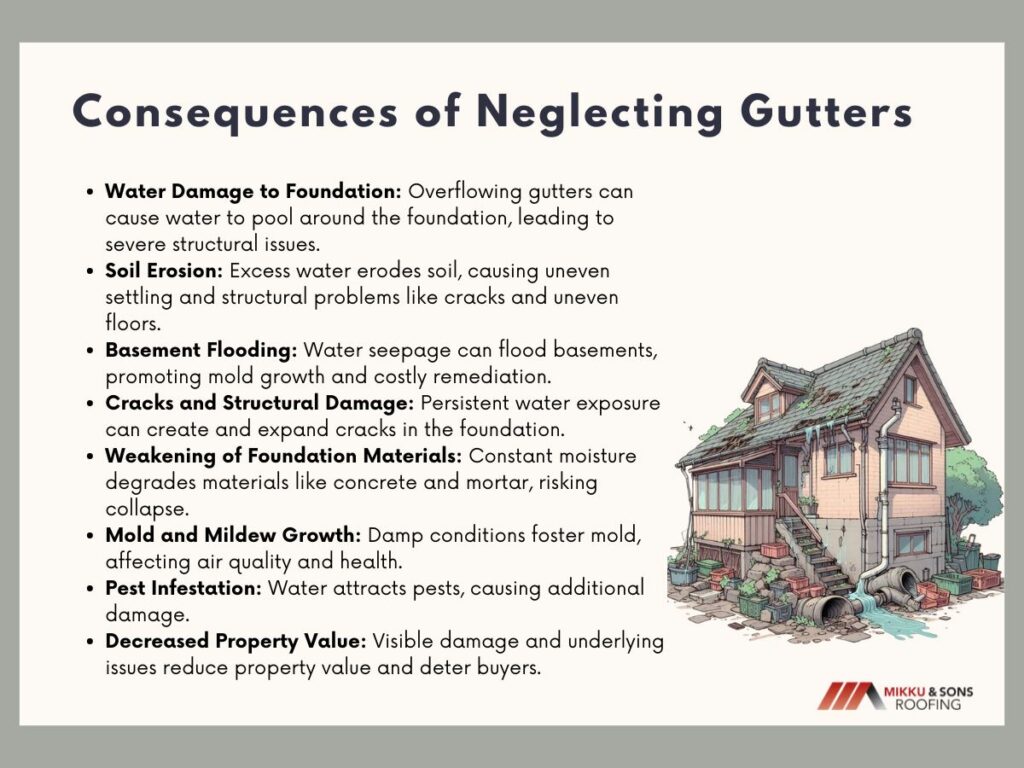
The primary function of gutters is to direct rainwater away from your home’s foundation. When gutters are clogged, overflowing, or damaged, they fail to perform this crucial task. The result is that water can overflow and pool around the foundation of your house, leading to a series of serious and costly issues.
One of the first consequences of water pooling around the foundation is soil erosion. The excess water can wash away the soil that supports your foundation, leading to an uneven settling of the house. Over time, this can cause significant structural problems, including cracks in the walls and floors, uneven flooring, and doors or windows that no longer close properly.
Water that collects near the foundation can seep into the basement or crawl space of your home. This seepage can lead to flooding, which not only damages the interior of the basement but also creates a conducive environment for mold and mildew growth. Mold can spread rapidly, posing health risks to your family and necessitating expensive remediation efforts.
Continuous exposure to water can cause cracks in the foundation. These cracks can vary from minor hairline fractures to significant structural fissures. Over time, these cracks can expand, compromising the stability of your home. Repairing foundation cracks is often a complex and expensive process that can be avoided with proper gutter maintenance.
Water infiltration can weaken the materials used in your foundation. Concrete and mortar, for instance, can degrade when subjected to constant moisture. This weakening reduces the foundation’s ability to support the weight of your home, potentially leading to a partial or total collapse in extreme cases.
Moisture around the foundation encourages mold and mildew growth. These fungi thrive in damp environments and can spread into your home, affecting indoor air quality and posing health risks such as allergies, respiratory issues, and other illnesses. Mold remediation can be costly and disruptive, making it essential to prevent its growth by ensuring proper water drainage through well-maintained gutters.
Water pooling near the foundation creates a hospitable environment for pests such as termites, ants, and rodents. These pests can cause significant damage to your home by chewing through wood and other building materials. Additionally, some pests can create nests within the gutter system itself, exacerbating the clogging issue and leading to further water damage.
The cumulative effects of water damage can significantly decrease your property’s value. Potential buyers are likely to be deterred by visible signs of foundation damage, mold issues, and pest infestations. Even if you manage to sell the house, the value may be significantly reduced due to these underlying problems.
Neglecting gutter maintenance can lead to significant financial implications, particularly when it comes to expensive repairs. Among these, the most notable expense is the cost of foundation repairs. When gutters fail to direct water away from the foundation due to clogs, damage, or improper installation, water seepage and soil erosion can occur, leading to severe foundation issues.
Water that accumulates around the foundation can cause soil erosion, leading to an uneven settling of the house. Over time, this can result in cracks and structural damage to the foundation.
Repairing foundation damage can be extremely costly, often requiring the services of specialized contractors. The expenses can range from a few thousand dollars for minor repairs to tens of thousands of dollars for extensive damage. The process typically involves excavating around the foundation, stabilizing the structure with piers or other methods, and then backfilling and restoring the landscaping.
The financial burden of these repairs underscores the importance of regular gutter maintenance. By keeping your gutters clean and functional, you can prevent water from damaging your foundation, thus avoiding the high costs associated with extensive repairs.
The cost of repairing gutters varies based on the material and extent of the damage. Here is a breakdown of the average repair costs per linear foot for popular gutter materials, including labor:
Cost: $4–$8 per linear foot
Vinyl gutters are among the most affordable to repair. They are lightweight and relatively easy to handle, which keeps labor costs low. However, vinyl is less durable than other materials and may require more frequent repairs or replacement over time.
Cost: $5–$8 per linear foot
Aluminum gutters are a popular choice due to their balance of cost and durability. They are resistant to rust and can handle a significant amount of water flow. Repairs for aluminum gutters typically involve sealing leaks, reattaching loose sections, or replacing damaged segments.
Cost: $10–$18 per linear foot
Steel gutters are more robust than vinyl or aluminum, making them suitable for areas with heavy rainfall or snow. However, they are prone to rust, which can increase repair costs. Fixing steel gutters often involves treating rust, sealing leaks, and occasionally replacing sections that have corroded.
Cost: $25+ per linear foot
Copper gutters are known for their durability and aesthetic appeal, but they come with a higher price tag. Repairs can be costly due to the material's expense and the specialized skills required to work with copper. Common repairs include fixing leaks and replacing damaged sections.
Cost: $30+ per linear foot
Zinc gutters are highly durable and have a long lifespan, making them a premium choice. The cost of repairing zinc gutters is high due to the material's price and the expertise needed for proper repairs. Zinc gutters are less prone to rust and corrosion, which can offset the higher initial and repair costs over time.
Several factors influence the cost of gutter repairs, including:
Regular gutter maintenance is crucial for preventing costly repairs and protecting your home's foundation. Neglecting this maintenance can lead to severe financial implications, including expensive foundation repairs and varied costs associated with fixing different types of gutters.
By keeping gutters clean and functional, homeowners can avoid water damage, soil erosion, and the high expenses of extensive repairs. Understanding the repair costs for various gutter materials—ranging from vinyl to zinc—highlights the importance of proactive maintenance. Investing in regular gutter upkeep is a small price to pay for safeguarding your home and avoiding significant financial strain.
Your roof is more than just a protective covering—it's a significant factor in determining the overall value and appeal of your property. In this blog, we'll explore the importance of choosing the right roofing material, focusing on asphalt shingles, and how it can affect your home's resale value.
Whether you're considering a roof replacement or building a new home, understanding the implications of your roofing choice is essential for maximizing your investment and attracting potential buyers.
The condition and type of roofing play a pivotal role in determining the resale value of a home. Potential buyers often scrutinize the roof as it is a critical component of the house's structure and provides protection from the elements. Here's how the condition and type of roofing can impact the resale value:
The condition of the roof significantly influences the resale value of a home. A well-maintained roof suggests to potential buyers that the property has been cared for and is less likely to have underlying issues. Conversely, a neglected roof with visible signs of damage or wear can deter buyers and lead to lower offers.
Common issues such as damaged or missing shingles, leaks, sagging areas, or signs of mold and mildew can signal potential problems with the roof's integrity. These issues not only decrease the aesthetic appeal of the property but also raise concerns about the need for immediate repairs or replacements, thus reducing the perceived value of the home.
An old roof nearing the end of its lifespan can also affect resale value. Buyers may view an aging roof as a future expense, prompting them to negotiate a lower price to accommodate the anticipated repair or replacement costs.
The type of roofing material used can also impact the resale value of a home. Different materials offer varying levels of durability, longevity, and aesthetic appeal, which can influence buyers' preferences and perceptions of value.
For instance, asphalt shingles, the most common roofing material, are relatively affordable and easy to install, making them a popular choice among homeowners. However, they typically have a shorter lifespan compared to other materials and may require more frequent maintenance and replacement, which could affect the long-term value of the property.
On the other hand, materials like metal roofing or clay tiles are known for their durability and longevity, offering potential buyers the reassurance of a roof that will last for decades with minimal maintenance. While these materials may come with a higher upfront cost, their durability and aesthetic appeal can enhance the resale value of the home.
A home's roofing system is its first line of defense against the elements, making it a critical factor in determining resale value. However, several common roofing issues can significantly lower the perceived value of a property:
Damaged or missing shingles are among the most common roofing issues that can detract from a home's resale value. Whether due to age, weather exposure, or improper installation, missing or broken shingles compromise the roof's ability to effectively shed water and protect the underlying structure.
Gaps in the roofing material can lead to leaks, water damage, and mold growth, further diminishing the property's value.
Roof leaks are a serious concern for homeowners and potential buyers alike. Even small leaks can result in significant water damage to the interior of the home, including ceilings, walls, insulation, and electrical systems.
Water damage not only degrades the structural integrity of the property but also poses health risks due to mold and mildew growth. Consequently, homes with a history of leaks or water damage are likely to experience decreased resale value and may require costly repairs to rectify the issue.
A sagging or uneven roof can indicate structural problems or inadequate support, causing concern for potential buyers. Structural issues may arise from a variety of factors, including age, poor construction, or water damage.
Regardless of the cause, a sagging roof poses risks to the safety and stability of the home, leading buyers to question the property's overall condition and value.
Excessive moisture due to leaks or inadequate ventilation can create an environment conducive to mold and mildew growth on the roof and in the attic space. Besides being unsightly, mold and mildew can compromise indoor air quality and pose health hazards to occupants.
Homes with visible mold or mildew on the roof may be perceived as poorly maintained and may experience decreased resale value as a result.
An aging roof nearing the end of its lifespan can also impact resale value. While regular maintenance can extend the life of a roof, older roofs may require more frequent repairs or replacement, leading potential buyers to negotiate lower prices to accommodate these anticipated costs.
An outdated roof style or material may detract from the property's curb appeal and overall value in the eyes of buyers.
To preserve home resale value, it's crucial to identify and address roofing issues proactively. Regular inspections play a key role in detecting potential problems before they escalate, allowing homeowners to take corrective action. Here's some practical advice on how to identify and address roofing issues:
Regular inspections and proactive maintenance are key to preserving the resale value of your home. By staying vigilant and addressing roofing issues promptly, you can ensure that your roof remains in good condition, enhancing the overall appeal and value of your property.
When considering roofing materials for your home, it's essential to weigh their impact on resale value. Asphalt shingles, one of the most popular roofing options, offer several advantages that can enhance the overall appeal and value of your property:

However, while asphalt shingles offer many benefits, it's essential to consider their potential impact on resale value:
The choice of roofing material can have a substantial impact on your home's resale value. While asphalt shingles offer affordability, versatility, and ease of installation, it's crucial to consider factors like durability, maintenance requirements, and perceived value when making your decision.
By carefully weighing these considerations and investing in high-quality roofing materials, you can enhance the curb appeal, functionality, and overall value of your property. Whether you're planning to sell in the near future or simply looking to protect your investment, choosing the right roofing material is a decision that pays dividends in the long run.
Within the construction industry, roofing contractors hold a pivotal role in ensuring the structural soundness and longevity of buildings. However, their significance transcends mere construction tasks, as they contribute substantially to economic prosperity at both local and regional levels.
This article explores the multifaceted ways in which local roofing contractors enrich economies, from job creation to community development, thereby illuminating their integral position within the economic fabric of society.
Roofing contractors are vital construction industry members, safeguarding buildings' structural integrity and durability. Yet, their contributions extend beyond maintenance and construction, significantly bolstering economic prosperity locally and regionally. They drive job creation, support local suppliers, and stimulate community development, leaving a lasting impact on various sectors of the economy.
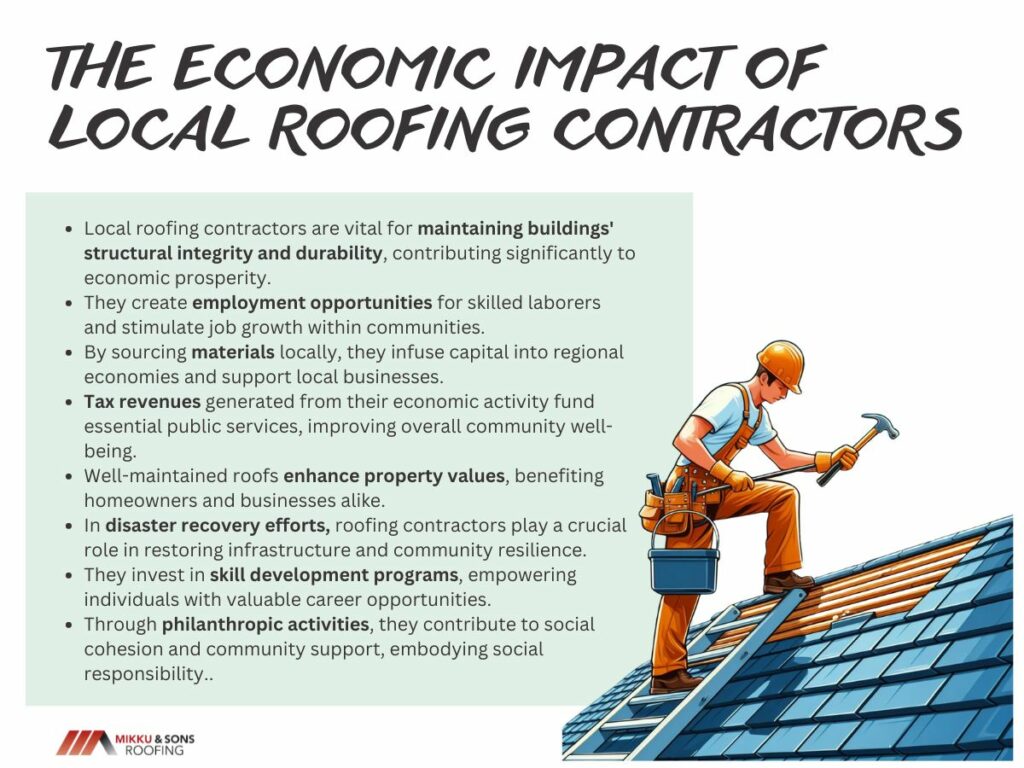
Local roofing contractors are significant employers, providing jobs to skilled laborers such as roofers, carpenters, and technicians. The consistent demand for roofing services ensures a steady stream of employment opportunities within communities, bolstering economic stability and providing livelihoods for families. Moreover, roofing projects often require collaboration with other trades, further expanding job opportunities across the construction sector.
Roofing projects necessitate the purchase of materials, equipment, and services, much of which is sourced locally. By patronizing local suppliers and vendors, roofing contractors infuse capital into the regional economy. This localized spending creates a ripple effect as dollars circulate within the community, benefiting businesses across various sectors and stimulating economic growth.
The economic activity generated by local roofing contractors translates into increased tax revenues for local governments. Taxes on corporate profits, employee wages, and sales transactions contribute to funding essential public services such as education, infrastructure, and healthcare. Thus, the contributions of roofing contractors have a direct impact on improving the overall quality of life within the community.
Well-maintained roofs are paramount for preserving the structural integrity and aesthetics of buildings. Local roofing contractors play a pivotal role in maintaining and repairing roofs, thereby safeguarding property values within neighborhoods. By ensuring that homes and commercial buildings remain structurally sound and visually appealing, roofing contractors indirectly contribute to property appreciation, benefiting homeowners and businesses alike.
Following natural disasters, such as hurricanes or severe storms, local roofing contractors are instrumental in facilitating recovery efforts. They respond swiftly to assess damage, make necessary repairs, and restore roofs to their pre-disaster condition. By expediting the restoration of shelter and infrastructure, roofing contractors contribute to community resilience, enabling residents and businesses to recover more swiftly from adversity.
Many local roofing contractors invest in workforce development programs and apprenticeship initiatives to nurture skilled labor within their communities. By providing training and educational opportunities, they ensure a pipeline of qualified workers capable of meeting industry demands. These initiatives not only enhance the competitiveness of local roofing businesses but also empower individuals with valuable skills and career prospects.
Beyond their economic contributions, local roofing contractors often engage in philanthropic activities and community outreach initiatives. Whether through volunteering time and resources or providing pro bono services to disadvantaged individuals or community organizations, these contractors demonstrate a commitment to giving back to the communities they serve. Such involvement fosters goodwill, strengthens social cohesion, and contributes to the overall well-being of the community.
Through job creation, localized spending, tax contributions, and various other means, they play a crucial role in bolstering local economies and enhancing the quality of life for residents. As pillars of their communities, roofing contractors exemplify how businesses can drive economic growth while simultaneously embodying social responsibility and community engagement.
Choosing the right roofing contractor for your project is crucial to ensure the success, durability, and safety of your roof. Local roofing contractors play a significant role in maintaining the integrity of buildings within their communities. Here are several key criteria and characteristics to consider when evaluating local roofing contractors:
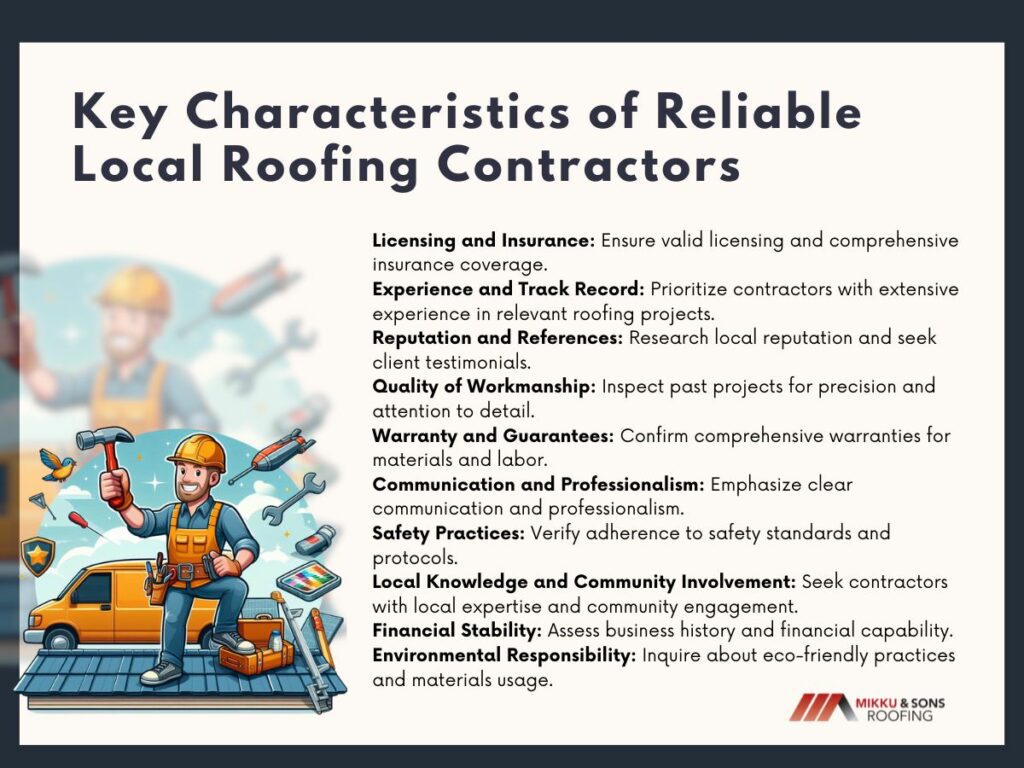
A reputable roofing contractor should be licensed to operate in their area and fully insured. Licensing demonstrates that the contractor has met the necessary requirements and possesses the expertise to perform roofing work safely and effectively. Adequate insurance coverage, including liability insurance and workers' compensation, protects both the contractor and the client in the event of accidents or damages.
Look for contractors with a proven track record of experience in the roofing industry, particularly in the type of roofing project you require. Experienced contractors are more likely to have encountered a variety of roofing challenges and possess the skills and knowledge to address them effectively. Reviewing past projects and seeking testimonials from previous clients can provide insight into the contractor's expertise and reliability.
Research the contractor's reputation within the local community. Seek out reviews and testimonials from previous clients to gauge their satisfaction with the contractor's workmanship, professionalism, and customer service. Additionally, ask the contractor for references and contact past clients directly to inquire about their experiences and level of satisfaction with the contractor's services.
Assess the quality of the contractor's workmanship by inspecting past roofing projects they have completed. Look for evidence of neatness, precision, and attention to detail. A reliable contractor takes pride in their work and ensures that roofs are installed or repaired to the highest standards, using quality materials and proven techniques.
A reputable roofing contractor should offer comprehensive warranties and guarantees for both materials and labor. Inquire about the warranties provided and ensure that they cover any potential defects or issues that may arise after the completion of the project. A contractor who stands behind their work with strong warranties demonstrates confidence in the quality and durability of their work.
Effective communication is essential throughout the roofing project. Choose a contractor who communicates clearly and transparently about project timelines, costs, and any potential issues that may arise. Professionalism, punctuality, and reliability are also important traits to look for in a contractor, as they contribute to a positive working relationship and project outcome.
Safety should be a top priority for any roofing contractor. Inquire about the contractor's safety practices and protocols to ensure that they adhere to industry standards and regulations. A reputable contractor should prioritize the safety of their workers, as well as the safety of your property and occupants during the roofing project.
A good local roofing contractor should have a deep understanding of the local climate, building codes, and regulations governing roofing projects in the area. They should also be actively involved in the local community, demonstrating a commitment to supporting and serving their neighbors.
Assess the financial stability of the roofing contractor to ensure they have the resources and capability to complete your project on time and within budget. Request information about the contractor's business history, creditworthiness, and ability to secure materials and equipment.
Increasingly, homeowners are seeking roofing contractors who prioritize environmental sustainability. Inquire about the contractor's practices regarding waste disposal, recycling, and use of eco-friendly materials and techniques.
By considering these key characteristics, you can confidently select a reliable local roofing contractor who will deliver quality workmanship, customer satisfaction, and peace of mind for your roofing project.
Beyond the immediate economic contributions outlined earlier, local roofing contractors offer further avenues through which they contribute to economic prosperity:
Local roofing contractors play a role in facilitating homeownership by ensuring that properties are well-maintained and structurally sound. A strong housing market, supported by quality roofing services, can attract prospective homebuyers and drive real estate transactions. As homeownership rates increase, so does economic stability and wealth accumulation within the community.
Beyond residential properties, local roofing contractors also contribute to the viability and growth of commercial establishments. Well-maintained roofs are crucial for businesses to operate smoothly and attract customers. By providing timely maintenance, repairs, and installations, roofing contractors support the continuity and expansion of businesses, thus fostering commercial growth and economic vitality.
The activities of local roofing contractors stimulate demand for ancillary industries, such as insurance, finance, and legal services. Insurance providers may offer policies tailored to protect homeowners and businesses against roofing-related risks, while financial institutions may provide loans or financing options for roofing projects. Additionally, legal services may be sought for contract negotiations, dispute resolution, and regulatory compliance, further contributing to economic activity and prosperity.
Local roofing contractors often participate in large-scale infrastructure projects, such as the construction or renovation of government buildings, schools, hospitals, and transportation facilities. By providing roofing expertise and services for these projects, contractors contribute to the development and modernization of essential infrastructure, which in turn supports economic growth, public services, and quality-of-life improvements within the community.
In an era of rapid technological advancement, local roofing contractors play a role in driving innovation and technology adoption within the construction industry. Contractors may invest in research and development to improve roofing materials, techniques, and equipment, leading to greater efficiency, sustainability, and cost-effectiveness. By embracing innovation, contractors position themselves as industry leaders and contribute to the competitiveness and dynamism of the local economy.
The economic activity generated by local roofing contractors has multiplier effects that extend beyond the initial investment. As roofing projects create jobs, stimulate spending, and generate income for workers and businesses, additional economic activity is triggered throughout the supply chain. This multiplier effect amplifies the impact of roofing projects, leading to broader economic benefits and prosperity for the community as a whole.
Consider these additional contributions, and it becomes evident that local roofing contractors play a multifaceted role in driving economic prosperity and fostering sustainable development within their communities. Through their expertise, innovation, and commitment to excellence, they contribute to the resilience, growth, and vitality of local economies in diverse and significant ways.
In summary, local roofing contractors are essential drivers of economic prosperity in their communities. While their primary role involves building, repairing, and maintaining roofs, their impact reaches far beyond their immediate tasks. They contribute to job creation, engage with suppliers, foster skill development, promote innovation, and drive infrastructure development.
Roofing contractors play a crucial role in maintaining vibrant and resilient economies through their dedication, expertise, and commitment to excellence. They are indispensable assets to local communities, vital for building and sustaining thriving economic environments.
Arizona's captivating landscapes and sun-drenched allure make it a coveted destination for prospective homeowners seeking a slice of desert paradise. Yet, amidst the excitement of envisioning a life in the Southwest lies a crucial consideration—the condition of the roof.
In this guide, we delve into the essential aspects of evaluating a home's roof before purchasing in Arizona. From material quality to sustainability considerations, each facet is explored to empower buyers to make informed decisions in securing their investment against the unique challenges of Arizona's dynamic climate.
Join us as we unravel the mysteries of Arizona's rooftops, paving the way for a future defined by comfort, security, and peace of mind amidst the stunning landscapes of the Grand Canyon State.
Purchasing a home in Arizona presents unique challenges, particularly when it comes to the roof. The state's climate, characterized by intense heat, prolonged sun exposure, and sporadic but heavy monsoon rains, places significant demands on roofing materials and structures. Therefore, a thorough examination of the roof is crucial before committing to a property purchase.
Here's a more detailed exploration of the key factors to consider:
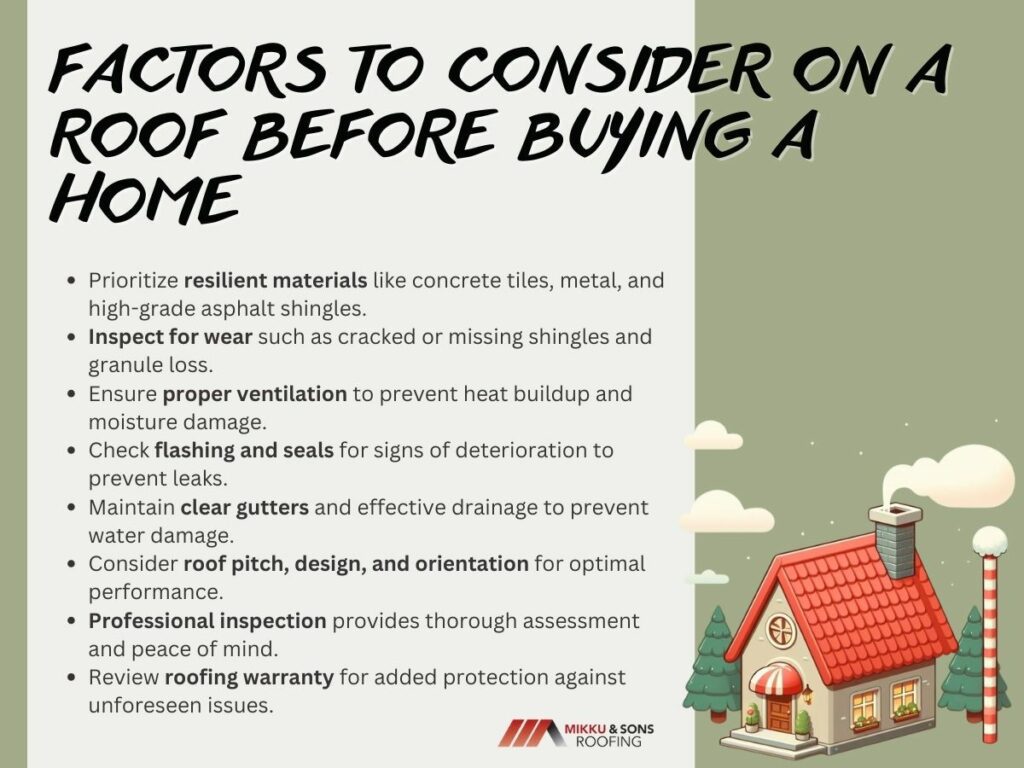
Arizona's climate demands resilient roofing materials. Concrete tiles, metal, and asphalt shingles are among the most common and suitable choices. These materials offer excellent durability and can withstand the extreme heat and sudden weather changes that characterize the Arizona landscape.
However, within each material category, there are varying levels of quality. Look for high-grade materials that come with warranties, ensuring longevity and peace of mind.
Beyond just a cursory glance, it's essential to meticulously inspect the roof for any indications of wear and tear. Cracked, curled, or missing shingles are obvious red flags that warrant attention. However, some issues may be less apparent.
Check for granule loss on asphalt shingles, which can indicate age and degradation. Additionally, examine the condition of the roof's underlayment, as deteriorating underlayment can compromise the roof's integrity.
Ventilation is paramount in Arizona, where the sun's relentless heat can quickly turn an improperly ventilated attic into an oven. Adequate ventilation not only helps regulate attic temperature but also prevents moisture buildup, which can lead to mold growth and structural damage.
Look for soffit vents, ridge vents, and attic fans, ensuring they are unobstructed and functioning correctly.
Flashing serves as a protective barrier around roof penetrations such as chimneys, vents, and skylights. It prevents water from seeping into vulnerable areas and causing leaks. Inspect the flashing closely for signs of corrosion, gaps, or deterioration.
Similarly, check the seals around roof penetrations for cracks or breaks, as these can compromise the roof's waterproofing capabilities.
Arizona's monsoon season brings intense, localized rainfall, making proper gutter and drainage systems essential for preventing water damage. Clogged or damaged gutters can lead to water pooling on the roof, which can accelerate deterioration and compromise structural integrity.
Ensure that gutters are securely attached, free of debris, and effectively channeling water away from the foundation.
The pitch and design of the roof influence its ability to withstand Arizona's weather extremes. Steeper roofs are better equipped to shed water and debris, reducing the risk of leaks and damage. Additionally, consider the orientation of the roof and whether it maximizes energy efficiency by minimizing sun exposure during the hottest parts of the day.
While a comprehensive visual inspection is essential, it's advisable to enlist the expertise of a professional roofing inspector. These specialists have the knowledge and tools to assess the roof's condition thoroughly, identifying hidden issues that may not be apparent to the untrained eye.
A professional inspection can provide valuable insights into the roof's overall health and remaining lifespan, helping you make an informed purchasing decision.
A warranty adds an extra layer of protection and reassurance when purchasing a home with a roof. Review the warranty terms and coverage carefully, ensuring it aligns with your expectations and provides adequate protection against unforeseen roofing issues.
A robust warranty can save you from significant financial burdens down the line, should any problems arise.
By meticulously evaluating material quality, signs of wear and tear, ventilation, flashing, drainage, roof design, and warranty coverage, you can ensure that your new home is equipped to withstand Arizona's weather extremes. Investing time and effort into a thorough roof inspection can ultimately save you from costly repairs and maintenance, providing peace of mind and long-term enjoyment of your property.
When purchasing a home in Arizona, it's crucial to prioritize assessing the condition of the roof, given the state's extreme weather conditions. Here are key red flags to be aware of:

The age of the roof is a critical factor to consider. Asphalt shingle roofs typically last around 15-20 years, while metal and tile roofs can last much longer. If the roof is nearing the end of its expected lifespan, it may require replacement soon, adding a significant expense to your homeownership costs.
Sagging or uneven areas on the roof may indicate structural issues or improper installation. These areas are more susceptible to water pooling, which can lead to leaks and structural damage over time.
Look for water stains on the ceilings and walls inside the house, as well as signs of water damage in the attic. These could indicate roof leaks or inadequate waterproofing, which may require extensive repairs.
Inquire about any previous roof repairs or replacements conducted on the property. While repairs are not necessarily a red flag, they should be thoroughly inspected to ensure they were performed correctly and are not masking underlying issues.
Look for signs of pest infestation, such as nests or droppings, as pests like rodents and birds can cause damage to the roof and compromise its integrity.
A neglected roof can be a significant liability. Suppose the roof appears poorly maintained, with overgrown vegetation, accumulated debris, or visible signs of neglect. In that case, it may be indicative of broader maintenance issues that could affect the home's overall condition.
Thoroughly evaluating the roof prior to purchase can help prevent unexpected expenses and ensure the home is equipped to withstand Arizona's challenging climate. Consulting with a qualified roofing contractor or inspector can provide further insight and guidance in this process.
Here are additional considerations to keep in mind when assessing the roof of a prospective home in Arizona:
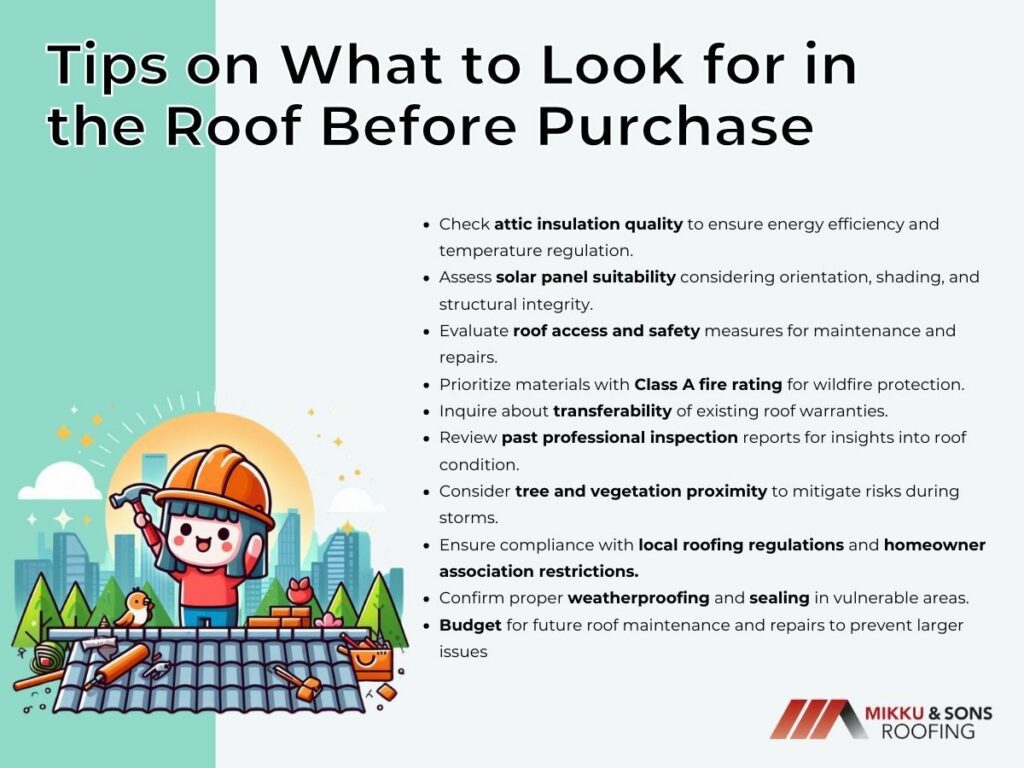
Verify the quality of attic insulation to ensure it meets current energy efficiency standards. Insulation aids in temperature regulation and reduces energy costs, which is especially crucial during Arizona's scorching summers.
Assess the roof's potential for solar panel installation, considering factors like orientation, shading, and structural integrity, which can significantly contribute to long-term energy savings in a state with abundant sunlight.
Evaluate the roof's accessibility and safety features, examining the presence of sturdy ladders, secure anchor points, and adequate barriers or guardrails to facilitate safe maintenance and repairs.
Prioritize materials with a Class A fire rating, offering superior protection against wildfires, an essential consideration given Arizona's wildfire risk.
Inquire about the transferability of any existing roof warranties to ensure continued coverage for potential issues post-purchase.
Obtain and review any past professional roof inspection reports for insights into the roof's condition, maintenance needs, and projected lifespan.
Consider the proximity of trees and vegetation to the roof, as overhanging branches may pose risks during storms and contribute to debris accumulation.
Familiarize yourself with local roofing regulations and potential homeowner association restrictions to ensure compliance with applicable guidelines.
Confirm proper weatherproofing and sealing to withstand Arizona's climate, paying attention to vulnerable areas like roof valleys, eaves, and transitions between materials.
Allocate funds for future roof maintenance and repairs, anticipating routine upkeep costs to prevent larger issues down the line.
By incorporating these additional considerations into your evaluation, you can make a more comprehensive assessment of the roof when purchasing a home in Arizona.
Buying a home in Arizona is exciting, but it's crucial to assess the roof thoroughly beforehand. Here are key benefits:
Checking the roof before buying a home in Arizona ensures financial protection, investment security, safety, peace of mind, and upgrade opportunities, facilitating a successful transaction.
In the vibrant tapestry of Arizona's housing market, the roof stands as a sentinel, guarding against the elements and preserving the sanctity of the home within. By meticulously evaluating material quality, structural integrity, regulatory compliance, and sustainability considerations, prospective buyers can navigate the complexities of the state's climate with confidence.
With each aspect of the roof carefully considered, buyers can make informed decisions that ensure long-term investment security and peace of mind. As they embark on their journey of homeownership amidst Arizona's stunning landscapes, they can rest assured that their abode is not just a shelter, but a fortress against nature's whims.
In closing, by prioritizing the condition of the roof, buyers pave the way for a future defined by comfort, security, and serenity amidst the captivating landscapes of the Grand Canyon State.
Renovating a roof is significant for any homeowner or property owner, often necessitated by age, wear and tear, or the desire for aesthetic or functional upgrades. However, what many might not realize is that roof renovation typically generates considerably more waste compared to installing a brand-new roof.
This extra waste results from disassembling preexisting materials, replacing damaged parts, and measuring and planning errors associated with remodeling projects. Reducing roofing waste during renovations has become crucial to sustainable construction methods as environmental concerns gain momentum.
Determining the origins of roofing waste is essential to developing measures limiting its environmental impact and lowering rehabilitation projects' ecological footprint.
It's important to understand the many sources contributing to the waste stream when restoring a roof. This allows homeowners and contractors to create focused waste reduction programs and optimize resources.
Every component involved in a renovation, from the outermost layer of shingles to the structural elements supporting the roof, contributes to waste production.
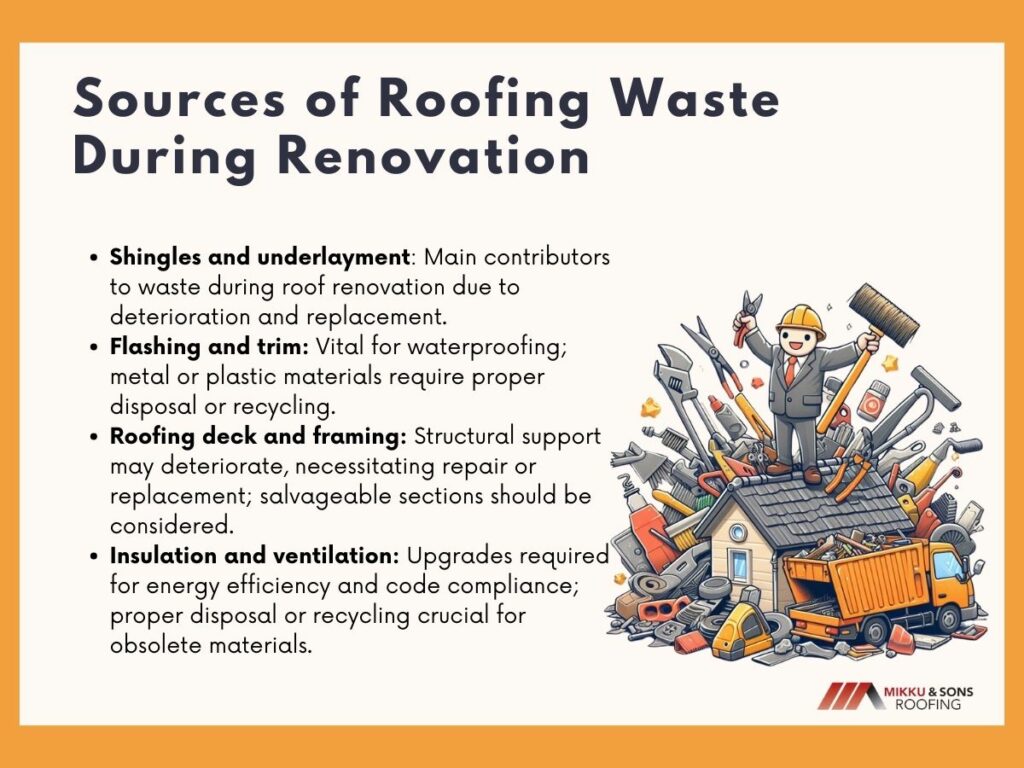
Shingles and underlayment form the primary defense against weather elements such as rain, snow, and UV radiation. Over time, these materials can deteriorate, leading to leaks, damage, or aesthetic concerns that prompt renovation.
During the removal process, old shingles and underlayment are typically torn off and discarded, contributing significantly to the waste generated.
Flashing and trim are essential components of a roof's waterproofing system, preventing water infiltration at vulnerable points such as roof edges, valleys, and intersections. While durable, flashing and trim may require replacement during renovation due to damage, corrosion, or aesthetic considerations.
As these components are often made of metal or plastic materials, proper disposal or recycling is essential to reduce the environmental impact of their disposal.
Beneath the visible layers of shingles and underlayment lies the roofing deck and framing structure, providing structural support and stability to the roof. Over time, these components may deteriorate due to moisture damage, rot, or pest infestation, necessitating repair or replacement during renovation.
However, not all roofing deck and framing materials need to be discarded entirely, as some sections may still be salvageable or suitable for restoration.
In addition to providing thermal insulation and moisture control, insulation and ventilation components play a crucial role in maintaining indoor comfort and energy efficiency. During roof renovation, insulation materials such as fiberglass batts or spray foam may need to be replaced or upgraded to meet current building codes and energy standards.
Similarly, ventilation components such as ridge vents or soffit vents may require inspection, repair, or replacement to ensure proper airflow and moisture management. It's critical to properly dispose of or recycle obsolete ventilation components and insulation during renovations to reduce waste and environmental damage.
It's important to understand that not every component of an old roof needs to be replaced before starting a renovation project. Reusing, refurbishing, or repurposing a large number of roof structure components will cut down on waste and lessen the renovation's negative environmental effects.
Reusable component evaluation and identification can help builders and homeowners embrace sustainable techniques that encourage conservation and resource efficiency.

Materials used for roof cladding, such as metal panels, asphalt shingles, and tiles, present a multitude of opportunities for imaginative repurposing beyond their initial function. Homeowners can use their creativity to turn these materials into distinctive, useful, and aesthetically beautiful elements for both indoor and outdoor areas.
Garden Pathways: Break old asphalt shingles into smaller pieces and use them as durable, weather-resistant materials for creating garden pathways or walkways. Their rough texture provides excellent traction, and their dark color can complement various landscaping themes.
Siding for Outdoor Structures: Repurpose intact asphalt shingles as cost-effective siding for outdoor sheds, playhouses, or chicken coops. Their lightweight nature and ease of installation make them an ideal choice for DIY projects, offering both durability and weather resistance.
Decorative Accents: Get creative with old asphalt shingles by using them as decorative accents in outdoor landscaping. Arrange broken shingles to create mosaic patterns in garden walls or stepping stones, adding a pop of color and texture to your outdoor spaces.
Wall Art: Cut and shape old metal roofing panels into unique wall art pieces for interior spaces. Whether you opt for abstract designs or intricate patterns, metal panels can add a touch of industrial-chic elegance to living rooms, bedrooms, or home offices.
Statement Pieces: Accept metal panels' adaptability by transforming them into eye-catching furniture. To combine practicality with a unique aesthetic, consider utilizing salvaged metal panels to create coffee tables, end tables, or shelving units.
Outdoor Décor: Take your outdoor décor to the next level with repurposed metal panels. Create striking privacy screens for patios or balconies, design custom trellises for climbing plants, or fashion eye-catching sculptures for garden landscapes, adding a touch of modern sophistication to your outdoor oasis.
Mosaic Accents: Use broken or mismatched roofing tiles to create vibrant mosaic accents for outdoor spaces. Arrange tiles in intricate patterns to adorn garden walls, fountain surrounds, or outdoor kitchen countertops, infusing your landscape with artistic flair.
Stepping Stones: Transform intact roofing tiles into charming stepping stones for garden pathways or stepping stone mosaic designs. Arrange tiles in various shapes and sizes, embedding them in concrete or gravel paths to create functional yet visually appealing walkways.
Tabletops and Countertops: Repurpose sturdy roofing tiles as tabletops or countertops for outdoor furniture or kitchen islands. Seal the tiles with weather-resistant coatings to protect against the elements, creating durable surfaces that withstand outdoor use while adding rustic charm to your outdoor entertaining spaces.
Trim and flashing components, typically made from materials like metal or plastic, are essential for waterproofing and finishing the edges, corners, and transitions of a roof. Rather than disposing of these components during a renovation, consider repurposing them into creative and practical features for both indoor and outdoor spaces.
Here are some inventive ways to transform trim and flashing:
Custom Signage: Use old metal flashing to craft custom signage for your home or garden. Cut the flashing into desired shapes and sizes, then paint or engrave letters and designs to create personalized address plaques, garden markers, or directional signs.
Artistic Décor: Turn metal flashing into striking pieces of wall art or sculpture for interior or exterior spaces. Bend, fold, or cut the flashing into geometric shapes or abstract forms, then mount them on walls or display them as freestanding sculptures to add modern sophistication to your décor.
Functional Furniture: Repurpose metal flashing into functional furniture pieces such as shelves, benches, or tables. Weld or fasten multiple pieces of flashing together to create sturdy frameworks, then add wooden or glass tops to transform them into stylish and durable furniture accents.
Vertical Gardens: Convert plastic trim components into vertical garden planters for indoor or outdoor use. Cut the trim into sections and attach them to walls or fences, then fill the compartments with soil and plant herbs, succulents, or small flowers to create living green walls that add beauty and freshness to your space.
Decorative Panels: Use plastic trim pieces to construct decorative panels or screens for privacy, shade, or aesthetic enhancement. Arrange the trim in geometric patterns or lattice designs, then attach them to existing structures such as pergolas, fences, or balcony railings to create visually appealing focal points in your outdoor living areas.
Playful Planters: Transform plastic trim components into playful planters for whimsical garden accents. Cut the trim into various shapes and sizes, then assemble them into creative arrangements such as animal shapes, abstract sculptures, or architectural landmarks.
Fill the planters with soil and colorful flowers or foliage to bring joy and character to your garden landscape.
Gutters and downspouts are integral components of a roofing system, directing rainwater away from the roof and foundation of the home to prevent water damage and erosion. Rather than discarding these components during a renovation, explore creative ways to repurpose them for functional and decorative purposes.
Here are several innovative ideas for reusing gutters and downspouts:
Repurpose old gutters as raised garden beds for growing herbs, vegetables, or flowers. Mount the gutters horizontally along fences, walls, or railings, then fill them with potting soil and plant your favorite crops or ornamental plants.
Gutter garden beds are ideal for small spaces, balconies, or areas with limited ground space.
Cut sections of gutters to create DIY planters for vertical gardening. Hang the gutter segments horizontally or vertically on walls, fences, or trellises, then fill them with soil and plant cascading flowers, succulents, or trailing vines.
Arrange multiple gutter planters to create living green walls or vibrant botanical displays.
Utilize gutters as practical organizers for storing and organizing gardening tools, hand tools, or craft supplies. Mount the gutters vertically on walls in garages, sheds, or workshops, then place tools, brushes, or other items within easy reach.
Gutter organizers help maximize storage space and keep essentials neatly organized.
Construct sturdy stands for rain barrels using repurposed gutters and downspouts. Cut sections of gutter to match the length and width of the rain barrel base, then assemble them into a rectangular frame.
Place the rain barrel on top of the gutter stand to elevate it for easy access and efficient rainwater collection.
Repurpose downspouts as vertical storage solutions for organizing umbrellas, walking sticks, or garden stakes. Mount downspouts vertically on walls or fences near entryways or outdoor living areas, then slide items into the openings for convenient access and clutter-free storage.
Roofing accessories, such as vents, skylights, and chimney caps, play vital roles in the functionality and aesthetics of a roof. Rather than discarding these components during a renovation, explore innovative ways to repurpose them for both practical and decorative purposes.
Here are several creative ideas for reusing roofing accessories:
Transform old roof vents into charming planters for indoor or outdoor use. Clean the vents thoroughly and fill them with potting soil, then plant herbs, succulents, or flowering plants to create unique botanical displays.
Hang the vent planters on walls, fences, or trellises to add greenery and character to your space.
Convert unused chimney caps into cozy birdhouses for feathered friends. Clean and paint the chimney caps with non-toxic, weather-resistant paint, then install them on poles or tree branches to provide nesting sites for birds.
Add perches, nesting boxes, and feeder trays to attract a variety of bird species to your backyard.
Use decorative patterns or stencils to transform plain roof vents into eye-catching design elements. Paint the vents with weather-resistant paints in bold colors or intricate patterns, then install them as decorative accents on exterior walls, fences, or garden sheds.
The decorative vent covers add visual interest and architectural flair to your outdoor spaces.
Repurpose old skylights into miniature greenhouses for starting seeds or growing small plants. Seal the edges of the skylights with weatherproof caulking or silicone, then place them on sturdy frames or tables in sunny locations.
Use the skylight greenhouses to extend the growing season or protect delicate plants from harsh weather conditions.
Turn old chimney caps into charming wind chimes for outdoor relaxation. Attach small bells, chimes, or decorative ornaments to the chimney caps using sturdy wires or strings, then hang them from tree branches, pergolas, or porch ceilings.
The chimney cap wind chimes create soothing sounds and add whimsical charm to your outdoor living spaces.
There are many chances for homeowners and contractors to embrace sustainability and creativity during the roof renovation process. Rethinking and repurposing roofing components and materials can help you reduce waste, save resources, and give your house and yard a distinctive look.
Knowing when to replace your roof is crucial to protecting your investment and maintaining the structural integrity of your house. Its lifespan can be increased with routine upkeep and repairs, but eventually, replacement is required.
How can you determine if your roof needs to be replaced? Continue reading to find out when you may put these waste-reduction techniques into practice. Think creatively and consider repurposing when you start your next roofing renovation project; often, the greatest ideas come from the stuff we already own.
Roofing systems are the first line of defense against the elements, shielding buildings from rain, snow, and harsh weather conditions. While surface materials such as shingles or tiles are essential components, the often overlooked hero in leak prevention is roof flashing. Acting as a silent guardian, roof flashing serves as a secondary barrier, sealing vulnerable points where water infiltration poses a significant risk.
In this article, we delve into the critical role of roof flashing in leak prevention and maintaining the structural integrity of buildings. From understanding the types of flashing to its importance in long-term protection and energy efficiency, we explore how proper flashing installation can safeguard roofs against water damage and ensure longevity.
Through examining various types of flashing and their applications, we underscore the significance of meticulous installation techniques and the selection of quality materials. Grasping the fundamentals of roof flashing is paramount for preserving the integrity of roofing systems.
In the realm of roofing, where weather elements relentlessly challenge the integrity of buildings, roof flashing emerges as a silent guardian against leaks and water damage. Often overlooked but fundamentally crucial, roof flashing serves as a secondary defense system, strategically sealing vulnerable points where water infiltration poses a significant threat.

One of the primary functions of roof flashing is to divert water away from vulnerable areas where leaks are most likely to occur. By directing water toward the roof's drainage system, flashing helps prevent moisture penetration and potential water damage to the building's interior.
Roof flashing acts as a barrier against water infiltration at critical junctures, such as roof-wall intersections, chimneys, and vents. Properly installed flashing creates a tight seal that prevents water from seeping into the underlying structure, preserving the integrity of the roof and the building as a whole.
A well-designed and properly installed flashing system can significantly extend the lifespan of a roofing system by minimizing the risk of leaks and water damage. Investing in quality flashing materials and installation can ultimately save homeowners time and money on costly repairs down the line.
Moisture buildup in the roof can lead to mold growth, wood rot, and structural deterioration over time. Roof flashing helps mitigate the risk of moisture infiltration by channeling water away from vulnerable areas and promoting proper ventilation and drainage within the roofing system.
Leaks in the roof can compromise the insulation and thermal performance of a building, resulting in increased energy consumption and higher utility bills. By preventing leaks and maintaining the integrity of the roof envelope, flashing contributes to improved energy efficiency and indoor comfort.
Roof flashing plays a vital role in leak prevention and the overall performance of roofing systems. Proper installation and maintenance of flashing are essential to ensure long-term protection against water infiltration and structural damage.
Whether building a new roof or repairing an existing one, attention to detail and adherence to best practices in flashing installation are key to preserving the integrity and durability of the roof for years to come.
Roof flashing comes in various forms, each tailored to address specific vulnerabilities in a roofing system. Understanding the different types of flashing and their applications is essential for ensuring comprehensive leak prevention and long-term structural integrity.
Below are some common types of roof flashing:
Step flashing is utilized at roof-wall intersections, such as where a sloped roof meets a vertical wall. It consists of individual pieces of metal, typically aluminum or galvanized steel, arranged in a stepped pattern. Each piece of flashing is installed beneath the overlapping shingles or siding, creating a tight seal that prevents water from penetrating the joint.
Chimneys are notorious sources of roof leaks due to their protrusion through the roof surface. Chimney flashing is specifically designed to create a waterproof barrier around the base of the chimney and along its sides. This type of flashing typically involves layers of metal, such as aluminum or copper, that are custom-fitted and sealed to the chimney and roof surface to prevent water infiltration.
Valleys, where two roof slopes meet, are susceptible to water accumulation and are prone to leaks if not adequately protected. Valley flashing is installed along these areas to channel water away from the joint and prevent it from infiltrating the roofing material. Valley flashing can be made of metal, such as galvanized steel or copper, and is typically installed beneath the roofing material to direct water toward the roof's edge.
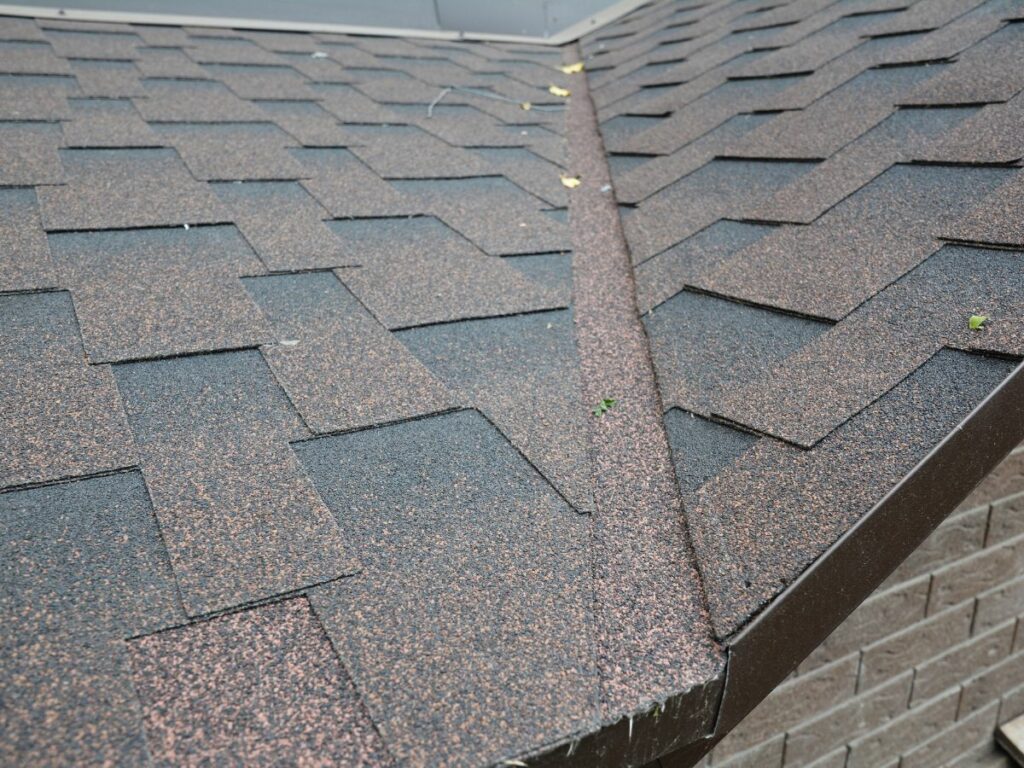
Plumbing vents and exhaust vents protruding through the roof require specialized flashing to maintain a watertight seal. Vent pipe flashing typically consists of a rubber boot that fits snugly around the vent pipe, with a metal base that is secured to the roof surface. This type of flashing prevents water from entering around the vent pipe while allowing for the movement of the pipe due to thermal expansion and contraction.
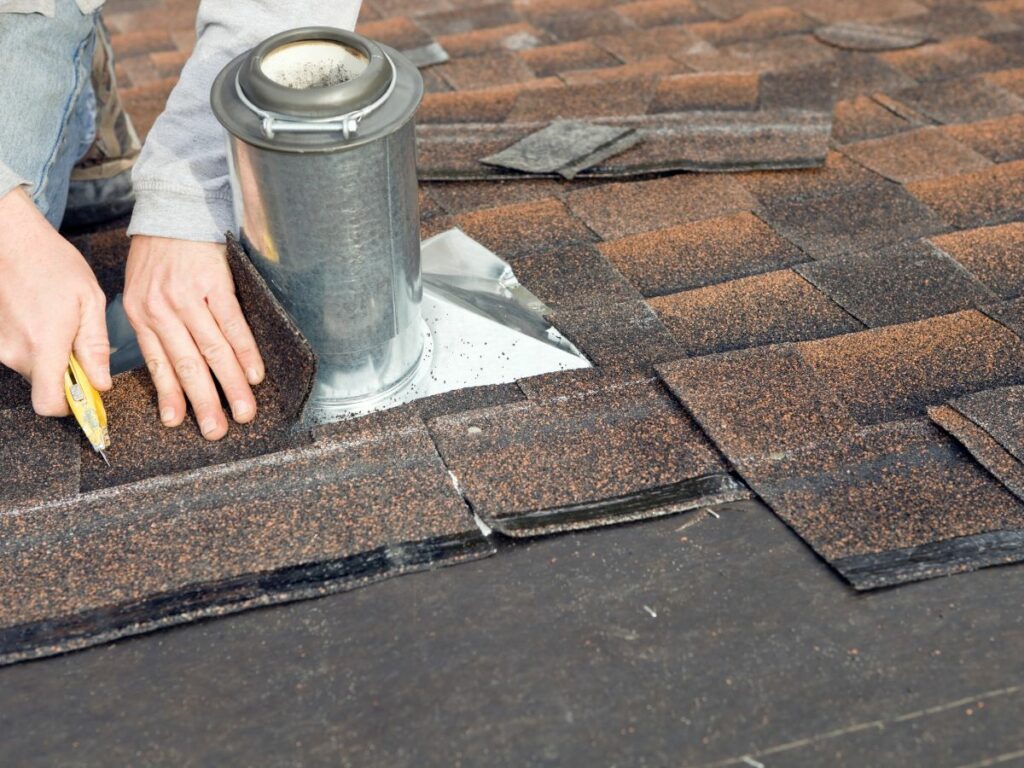
Drip edge flashing is installed along the edges of the roof to direct water away from the fascia and prevent it from seeping into the roof deck. It typically consists of a metal strip with a bent edge that extends slightly over the roof's edge, guiding water into the gutters or off the roof surface. Drip edge flashing helps protect the underlying roof structure from water damage and prolongs the lifespan of the roofing material.
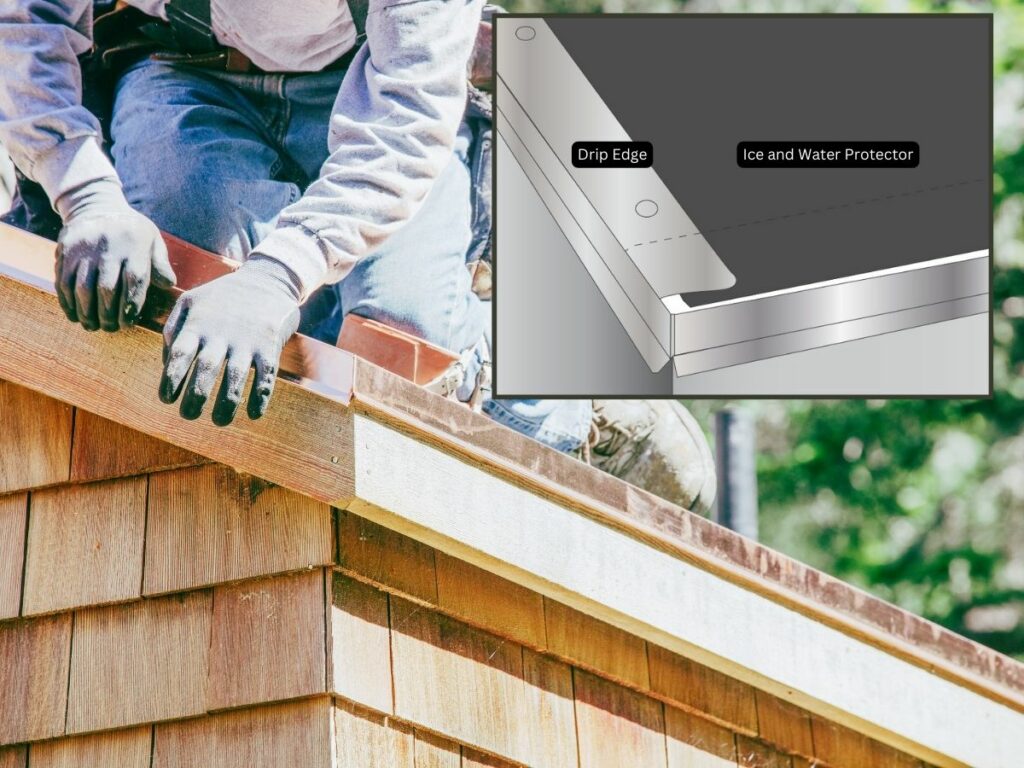
Skylights pose a risk of water infiltration if not properly flashed. Skylight flashing is specifically designed to create a watertight seal around the perimeter of the skylight opening. It typically consists of a combination of metal flashing and specialized sealants that are installed to prevent water from entering the skylight frame.
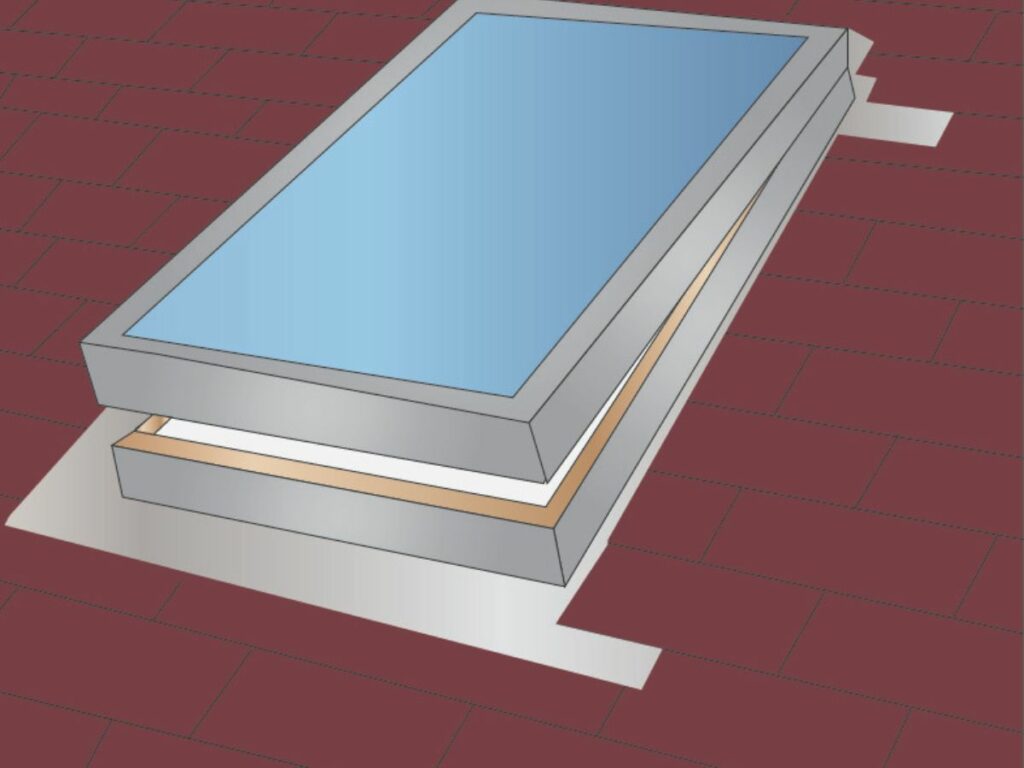
Each type of roof flashing serves a unique purpose in protecting vulnerable areas of a roofing system from water infiltration and leaks. By understanding the different types of flashing and their applications, homeowners and contractors can ensure comprehensive leak prevention and long-term structural integrity for their roofs.
Proper flashing installation and maintenance are essential for maximizing its effectiveness and prolonging the lifespan of the roofing system.
Extending the life of roof flashing is essential for maintaining a watertight roofing system and preventing leaks. Here are some tips to help prolong the lifespan of roof flashing:
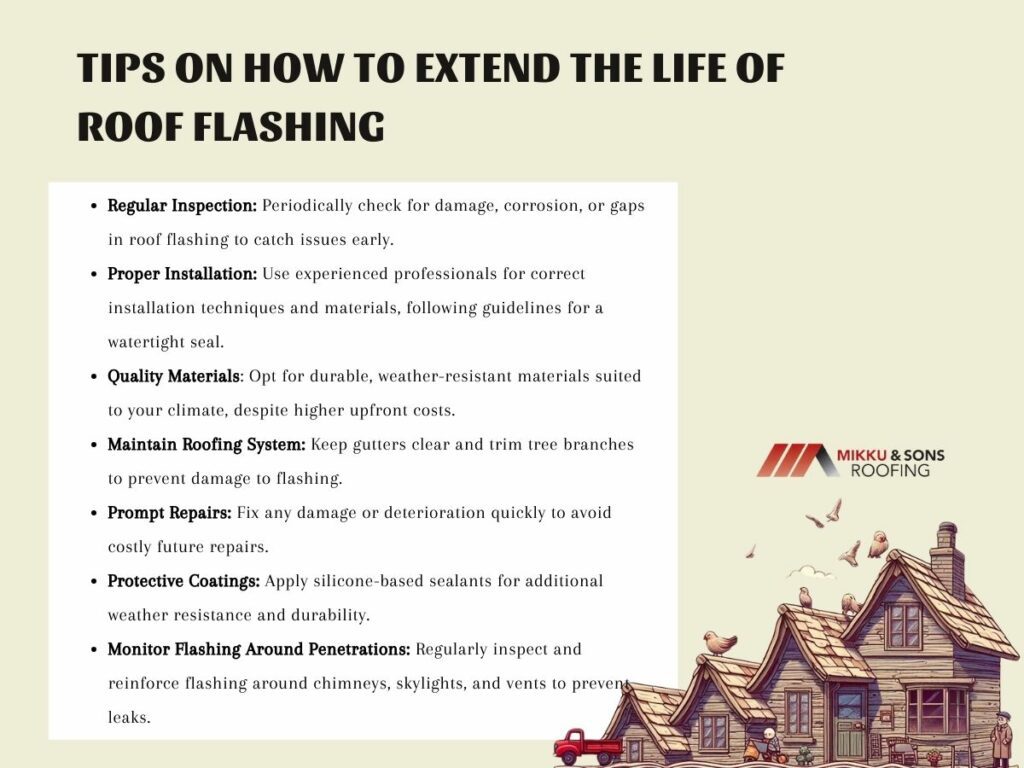
Conduct periodic inspections of the roof flashing to check for signs of damage, corrosion, or deterioration. Look for gaps, cracks, or areas where the flashing has pulled away from the surface. Early detection of issues allows for timely repairs, preventing water infiltration and extending the lifespan of the flashing.
Ensure that experienced professionals use appropriate techniques and materials to install roof flashing correctly. Proper flashing installation involves securely attaching the flashing to the roof surface, applying sealants as needed, and overlapping flashing pieces to create a watertight barrier. Following manufacturer guidelines and industry best practices during installation helps maximize the effectiveness and durability of the flashing.
Invest in high-quality flashing materials that are designed to withstand weather exposure and resist corrosion. Choose flashing materials that are compatible with the roofing material and climate conditions of your area. Quality flashing materials may cost more upfront but can offer greater durability and longevity, ultimately saving money on repairs and replacements in the long run.
Proper maintenance of the entire roofing system, including shingles, underlayment, and gutters, can help prevent damage to the flashing. Keep gutters and downspouts clear of debris to ensure proper drainage and minimize the risk of water backup that could damage flashing. Trim overhanging tree branches to prevent them from rubbing against the roof and causing damage to the flashing.
If you notice any signs of damage or deterioration in the roof flashing, such as rust spots, cracks, or loose sections, address repairs promptly. Ignoring minor issues can lead to more extensive damage and costly repairs down the line. Hire a qualified roofing contractor to assess the condition of the flashing and perform necessary repairs using quality materials and techniques.
Consider applying protective coatings or sealants to the roof flashing to enhance its durability and resistance to weathering. Silicone-based sealants can help create a waterproof barrier and improve the longevity of the flashing. Consult with a roofing professional to determine the most suitable coating or sealant for your specific flashing material and environmental conditions.
Pay special attention to roof flashing around penetrations such as chimneys, skylights, vents, and pipes, as these areas are particularly vulnerable to leaks. Inspect the flashing regularly and ensure that it remains properly sealed and intact. Consider installing additional flashing or flashing boots as needed to reinforce vulnerable areas and prevent water infiltration.
By following these tips and taking proactive measures to maintain and protect roof flashing, you can help extend its lifespan and ensure the long-term integrity of your roofing system. Regular inspections, proper installation, quality materials, and timely repairs are key to maximizing the effectiveness and durability of roof flashing, ultimately saving you time and money on costly repairs and replacements.
In summary, roof flashing serves as a silent but essential guardian, protecting our homes and buildings from the relentless assault of rain, snow, and harsh weather conditions. Its role in preventing leaks and preserving the structural integrity of roofing systems is paramount yet often overlooked.
Through regular inspections and proactive maintenance, we can ensure that roof flashing remains effective. Proper installation techniques, coupled with the use of high-quality materials, further bolster the flashing's resilience against the elements.
By recognizing the significance of roof flashing and investing in its care, we safeguard our properties and ensure the longevity and durability of our roofing systems. In doing so, we uphold the integrity of the structures we inhabit, providing a safe and secure environment for ourselves and future generations to come.
Your roof serves as the first line of defense against the elements, enduring scorching sun, pounding rain, biting wind, and heavy snow. Over time, wear and tear can weaken its defenses, potentially leading to costly damage if ignored.
Recognizing when to replace your roof is essential for safeguarding your investment and preserving your home's integrity. While regular maintenance and repairs can extend its lifespan, there comes a point when replacement becomes necessary.
In this article, we'll explore seven unmistakable signs indicating it's time for a roof replacement. These warning signals, from visible damage to hidden vulnerabilities, offer valuable insights into your roof's condition, aiding informed decisions about maintenance and upkeep.
Recognizing the right time to replace your roof is crucial for upholding your home's integrity and preventing expensive repairs. Here are seven clear indicators that suggest it's time to consider investing in a roof replacement.
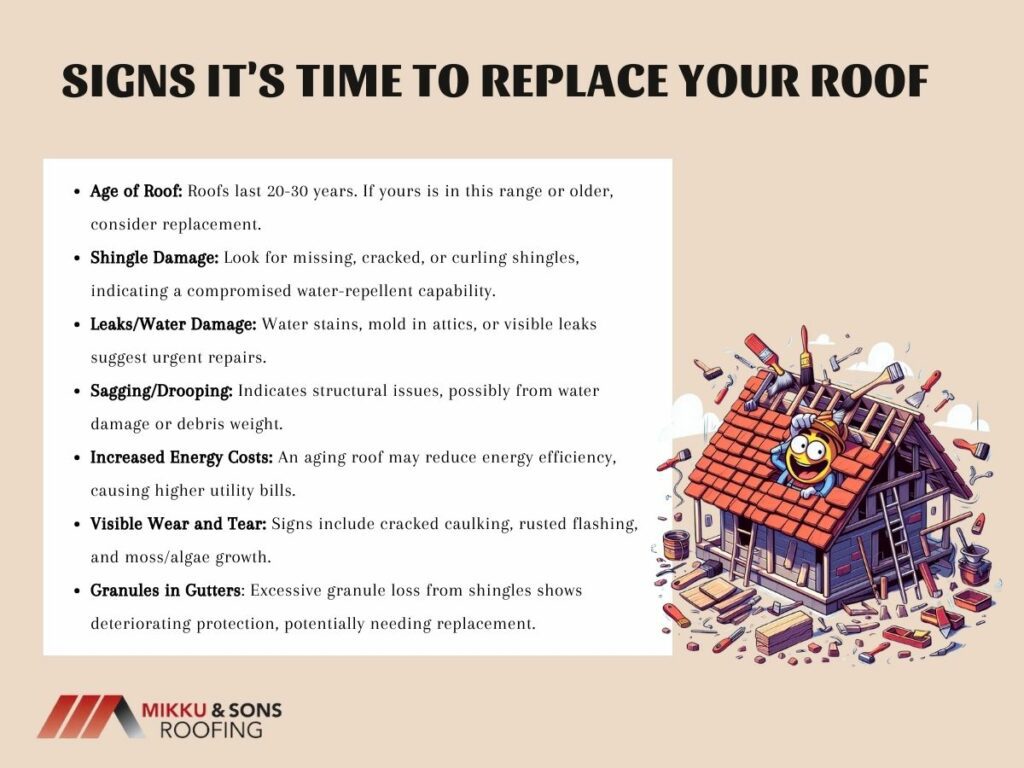
Roofs typically have a lifespan of 20 to 30 years, depending on the materials used and environmental factors. If your roof is nearing or has exceeded this age range, it's a clear indication that replacement is due, regardless of visible damage.
Inspect your roof for missing, cracked, or curling shingles. Damaged shingles compromise your roof's ability to repel water, increasing the risk of leaks and further deterioration.
Water stains on ceilings or walls, mold growth in attics, and signal roof leaks that require immediate attention. Ignoring these issues can lead to extensive damage to your home's interior structure.
A sagging roof indicates structural issues, potentially caused by water damage or the weight of debris. If you notice any sagging or drooping areas, it's crucial to have your roof inspected promptly.
An aging roof can reduce your home's energy efficiency, resulting in higher heating and cooling bills. If you've noticed a significant increase in energy costs, your roof may be due for replacement.
Check for signs of wear and tear, such as cracked caulking, rusted flashing, or moss and algae growth. These issues can indicate underlying problems that may worsen over time.
Excessive granule loss from asphalt shingles suggests that your roof's protective surface is deteriorating. This compromises its ability to withstand weather conditions and may necessitate replacement.
By addressing these telltale signs promptly, you can avoid costly damage and ensure the long-term durability of your home. If you need clarification on the condition of your roof, consult with a professional roofing contractor for an assessment and recommendations.
When replacing your roof, several important factors should be considered to ensure a successful and long-lasting installation. These factors include:
Choose the appropriate roofing material based on factors such as durability, aesthetics, climate suitability, and budget. Common options include asphalt shingles, metal roofing, tile, wood shakes, and synthetic materials.
Selecting a reputable and experienced roofing contractor is essential for a quality installation. Research potential contractors, check their credentials, read reviews, and request quotes from multiple companies before making a decision.
Familiarize yourself with local building codes, regulations, and permit requirements for roof replacements in your area. Ensure that your roofing project complies with all necessary regulations to avoid potential fines or legal issues.
Consider the architectural style of your home and choose a roofing design and color that complements its aesthetic appeal. Consult with your roofing contractor to explore different design options and find the best fit for your home.
Proper ventilation and insulation are crucial for maintaining energy efficiency and preventing moisture buildup in your attic. Discuss ventilation and insulation options with your contractor to ensure optimal performance and comfort.
Determine your budget for the roof replacement project, including material costs, labor expenses, and any additional fees. Explore financing options, such as loans or payment plans, if needed, to help cover the upfront costs of the project.
Inquire about warranties offered by the roofing manufacturer and contractor, including coverage for materials and workmanship. Additionally, discuss ongoing maintenance requirements and schedule periodic inspections to prolong the lifespan of your new roof.
Consider the weather and timing of your roof replacement project to minimize disruptions and ensure optimal conditions for installation. Plan the project during a time of year with favorable weather conditions and allow sufficient time for completion.
By carefully considering these factors and working closely with your roofing contractor, you can ensure a successful and satisfactory roof replacement that enhances the beauty, functionality, and value of your home.
Selecting the right roofing material is crucial for the durability, aesthetics, and performance of your roof. Here are some recommended roofing materials based on various factors:
When choosing a roofing material, consider factors such as climate, budget, aesthetic preferences, durability, and maintenance requirements. Consult with a roofing professional to determine the best option for your specific needs and preferences.
Expanding the lifespan of your new roof requires proactive maintenance and careful attention to various factors that can affect its longevity. Here are some tips to help you maximize the lifespan of your roof:
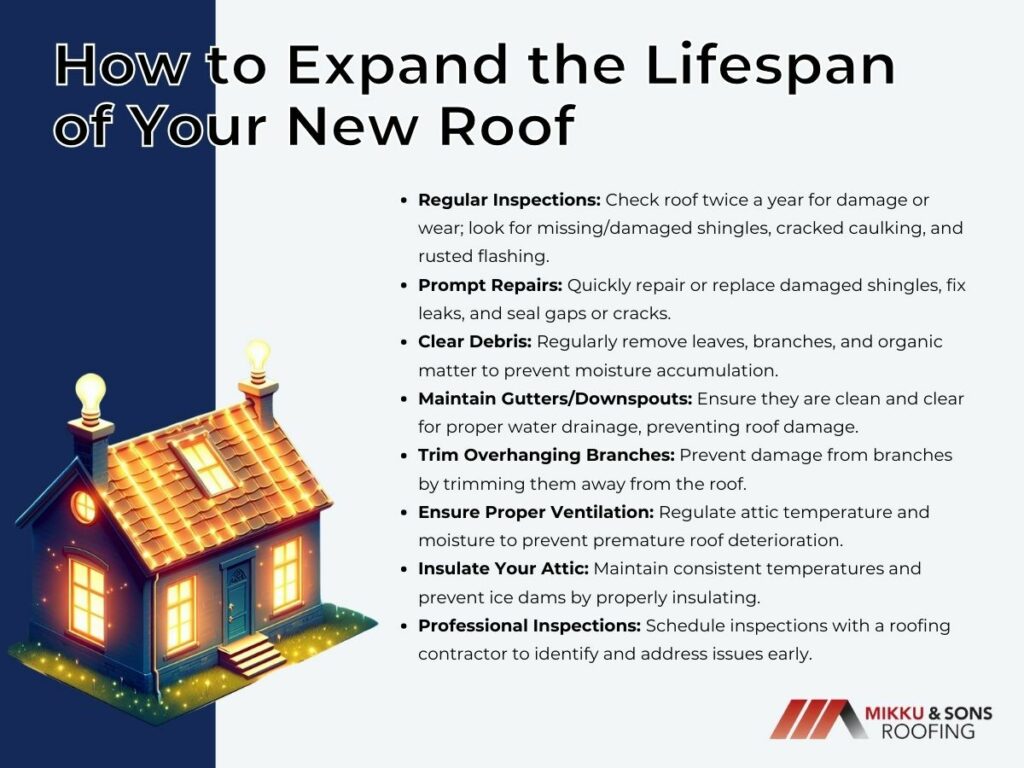
Conduct regular visual inspections of your roof, ideally twice a year, to check for signs of damage, wear, or deterioration. Look for missing or damaged shingles, cracked caulking, rusted flashing, and any other issues that may require attention.
Address any roofing issues promptly to prevent them from worsening and causing further damage to your roof and home. Repair or replace damaged or missing shingles, fix leaks, and seal any gaps or cracks in the roof as soon as they are identified.
Keep your roof clear of debris, such as leaves, branches, and other organic matter that can accumulate and trap moisture. Remove debris regularly to prevent water from pooling and causing damage to the roof structure and materials.
Clean and inspect your gutters and downspouts regularly to ensure proper drainage and prevent water from backing up and damaging your roof. Remove leaves, dirt, and debris from gutters and downspouts to prevent clogs and water buildup.
Trim back overhanging branches from trees near your roof to prevent them from rubbing against or falling onto the roof during storms or high winds. Branches can cause damage to shingles, gutters, and other roofing components if left unchecked.
Proper attic ventilation is essential for regulating temperature and moisture levels in your attic space, which can affect the lifespan of your roof. Ensure that your attic is adequately ventilated to prevent moisture buildup and heat buildup, which can lead to premature roof deterioration.
Proper attic insulation helps maintain consistent indoor temperatures, reducing the workload on your HVAC system and preventing ice dams from forming on the roof during winter. Adequate insulation also helps prevent heat from escaping through the roof, reducing the risk of snow melting and refreezing, which can cause damage to shingles and gutters.
Hire a professional roofing contractor to perform periodic inspections of your roof to assess its condition and identify any potential issues that may need attention. Professional inspections can help catch problems early and extend the lifespan of your roof.
By following these tips and investing in regular maintenance and inspections, you can help extend the lifespan of your new roof and protect your home for years to come.
Your roof serves as a critical barrier against the elements, safeguarding your home and family. Over time, wear and tear can compromise its effectiveness, necessitating replacement to preserve your home's integrity and avoid costly damage.
By recognizing the signs indicating the need for a replacement and carefully considering factors such as materials, contractor selection, regulations, design, and maintenance, you can ensure a successful roof replacement project.
Additionally, implementing proactive measures to extend the lifespan of your new roof, such as regular inspections, prompt repairs, and proper maintenance, will further protect your investment and provide peace of mind for years to come. With careful planning and attention to detail, you can ensure that your home remains secure and protected with a durable and long-lasting roof.
Any structure must have roof drainage systems because they are the first line of defense against structural deterioration and water damage. These systems are essential for controlling the runoff of rainfall, keeping it off the roof, and safely diverting it away from the building.
Ensuring efficient water flow in roof drainage systems is really important. Effective water drainage maintains the lifespan of the building as well as the integrity of the roof. Drainage systems are strategically designed and incorporated to disperse water from regions prone to damage.
This reduces the need for expensive repairs and guarantees the roof's durability over time. Following regulations for installing drainage systems guarantees that safety requirements are met and protects the property from possible legal risks.
Residential, commercial, and industrial buildings frequently have flat roof systems, which are distinguished by their low pitch or slope. Flat roofs have an almost horizontal surface compared to pitched roofs, which have a sharp incline that helps in water runoff.
As a straightforward and affordable roofing option, flat roofs normally consist of a membrane layer, insulation, and a structural deck.
| Drainage System | Description |
| Internal Drains | Installed within the roof surface to collect water and direct it to a drainage system. |
| External Drains | Positioned along the edges of the roof or at strategic points to channel water off the roof. |
| Scuppers | Openings in the parapet wall or roof edge that allow water to drain from the roof surface. |
| Siphonic Roof Drains | Advanced drainage systems that use negative pressure to draw water at high velocities. |

Scuppers are openings in the parapet wall or the edge of the roof that allows water to drain from the roof surface to the exterior and serve as essential outlets for rainwater runoff, minimizing the risk of ponding. They are typically fitted with downspouts or pipes to direct water away from the building's foundation.
Scuppers should be strategically positioned along the roof's perimeter to facilitate uniform water distribution and prevent localized pooling. Additionally, the size of the scupper openings should be proportionate to the roof area and anticipated rainfall intensity to prevent overflow and ensure efficient water flow.
With the use of a network of pipes and specially engineered drain heads, siphonic roof drains generate a suction that draws water off the roof and into the drainage system. Siphonic drains work by drawing water down the drainage pipes at rapid speeds using negative pressure, as opposed to standard drains that depend on gravity.
Siphonic drains are especially useful in regions with excessive rainfall or expansive roof areas where conventional drainage techniques would not be enough due to their high flow rates. Additionally, they can simplify the entire drainage system design and installation procedure by lowering the number of drain points that are needed on the roof.
The tapered insulation directs water toward specified drainage locations, which is intended to create a little slope on the flat roof surface. It is a good way to deal with places where water pools and also enhances the building's thermal efficiency and water flow efficiency through the roof.
Tapered insulation systems work well with various roofing materials and can be tailored to meet the unique needs of the roof.
Gutter problems are common despite their important function; these can range from jams from leaves and debris to sagging from heavy snowfall or rainfall. Water penetration and structural damage are less likely when gutters are constructed and maintained properly, preventing water from building up along the roof's edges.
Gutter guard installation is one way to stop debris accumulation; other solutions include ensuring the pitch is right for water flow and fixing leaks and damage immediately. Downpipe installation and sizing must be done correctly to guarantee unrestricted water flow and avoid backups or spills.
Sloped roof systems are designed with a pitched or angled surface that allows for natural water runoff. The angle or pitch determines the roof's slope, which dictates the rate at which water drains off the roof surface.
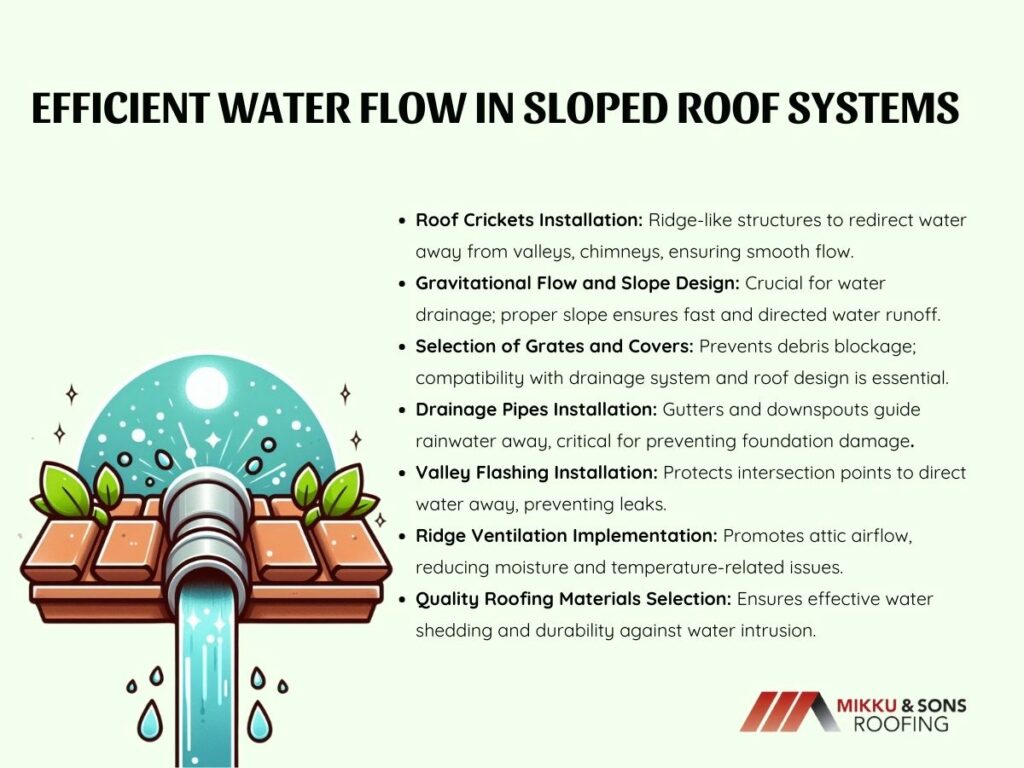
The primary function of a sloped roof is to provide a protective barrier against environmental elements, including rain, snow, and debris. The angled design of sloped roofs allows water to flow downhill, away from the roof surface, reducing the risk of water infiltration and damage to the building structure.
Roof crickets, also known as saddles or diverter roofs, are ridge-like structures installed on the roof surface to redirect water away from problem areas such as valleys, chimneys, or equipment. They are typically constructed with a slope that directs water towards drainage points, preventing water from pooling in low-lying areas and facilitating smooth water flow.
The design of the roof slope plays a crucial role in facilitating efficient water flow in sloped roof systems. The pitch or slope of the roof determines the direction and speed at which water flows off the roof surface.
Roof slopes are typically designed to comply with local building codes and standards, ensuring adequate drainage capacity based on roof size, rainfall intensity, and roof pitch. Proper slope design promotes gravitational flow, allowing water to drain away from the roof and prevent water accumulation naturally.
Grates and covers are integral components of roof drain systems, helping to prevent debris, leaves, and other materials from entering and obstructing the drainage system. Properly selected grates and covers should be compatible with the type of drain system and roof design, ensuring efficient water flow while providing protection against blockages.
Gutters and downspouts are essential components of sloped roof drainage systems, collecting rainwater from the roof surface and directing it away from the building foundation. Downspouts are vertical pipes that direct water from the gutters to the ground or drainage system, whereas gutters are normally located along the roof's eaves.
Properly sized gutters and downspouts are essential conduits for transporting collected rainwater from the roof to designated drainage points, such as downspouts or stormwater systems. Proper installation and sizing of drainage pipes are critical to ensure unrestricted water flow and prevent backups or overflows.
Valleys, where two roof planes intersect, are vulnerable areas prone to water accumulation and leaks. Valley flashing, typically made of metal or waterproof membrane, is installed along the valleys to direct water away from these areas and prevent water infiltration.
Ridge ventilation systems are installed along the ridge of the roof to promote airflow and prevent moisture buildup in the attic space. Proper ventilation helps control temperature and humidity levels to lower the chance of condensation and moisture-related problems like mold development and wood rot.
Ridge vents allow warm, moist air to escape from the attic while drawing in cooler, drier air from the exterior, promoting efficient airflow and preventing moisture buildup.
The choice of roofing materials greatly impacts the effectiveness of water flow in systems with sloped roofs. Premium roofing materials are made to effectively shed water and fend off water intrusion, including metal panels, asphalt shingles, and tiles.
For long-term durability and to stop water intrusion, roofing materials must be installed correctly, including overlapping seams and appropriate flashing details.
Efficient water flow in roof drainage systems is crucial for maintaining the integrity of the building structure and preventing water-related damage as discussed above. However, various challenges can arise that hinder the effectiveness of these systems.
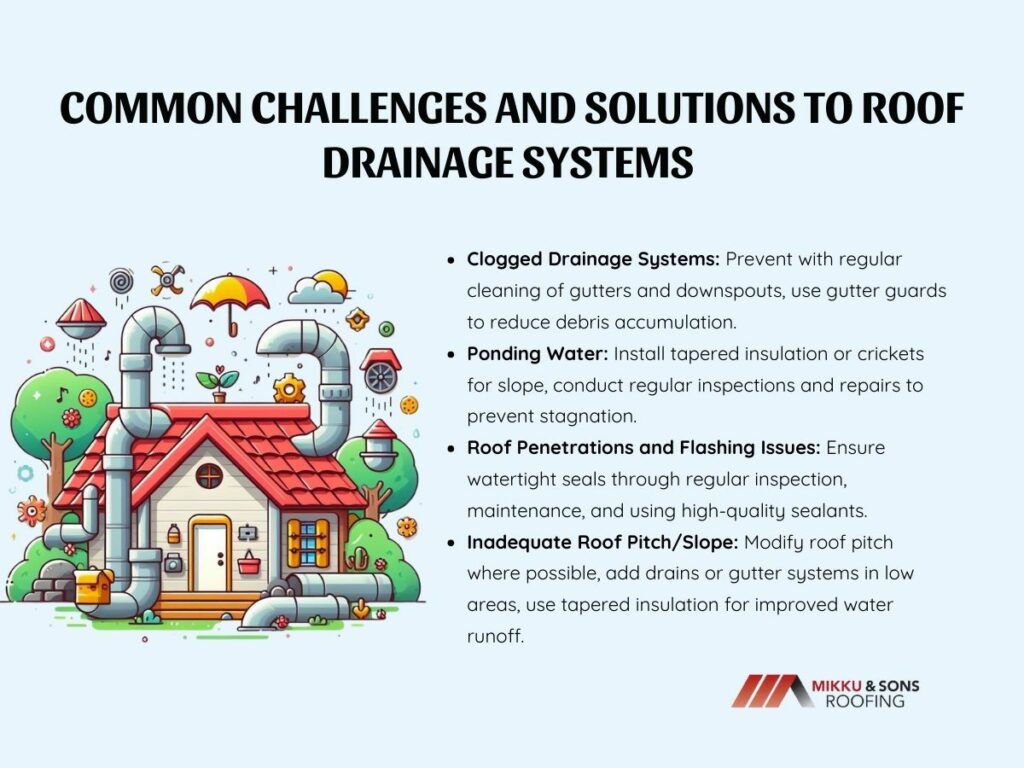
Debris, such as leaves, twigs, and sediment, can accumulate in gutters, downspouts, and drains, obstructing the flow of water and causing backups. This can be prevented through regular maintenance.
This includes cleaning gutters and downspouts at least twice a year, especially after heavy storms or during the fall when leaves are prevalent. Installing gutter guards or screens can help prevent debris buildup while still allowing water to flow freely.
Ponding water occurs when water collects and remains stagnant on the roof surface, leading to structural damage, leaks, and mold growth. Installing tapered insulation or crickets helps create a slope that directs water toward drainage points.
Regular inspections to identify low spots or debris accumulation and prompt repairs or adjustments can prevent ponding. Considering roof slope during initial design or renovation can also minimize the risk of ponding.
Roof penetrations such as vents, chimneys, and skylights, along with flashing details, are vulnerable areas where water can infiltrate if not adequately sealed. This can be curbed through regular inspection and maintenance.
Checking for signs of deterioration or damage and resealing or replacing flashing as needed ensures watertight seals. Using high-quality sealants compatible with roofing materials and following manufacturer guidelines for installation helps prevent leaks around penetrations.
Insufficient roof pitch or slope can hinder water drainage, leading to ponding and water infiltration, particularly in flat or low-slope roofs. Modifying the roof pitch or slope, where feasible, improves water runoff.
Installing additional drains, scuppers, or gutter systems in low-lying areas facilitates drainage. Tapered insulation can also be added to create a slope and promote water flow.
Even the most well-planned roof drainage systems may become useless if gutters are ignored. Debris accumulation in gutters can disrupt the water's natural flow, causing leaks and backups and even damaging the building's interior and roof.
It is, therefore, essential to have a profound awareness of the importance of gutter maintenance in addition to knowing how to guarantee appropriate water flow in roofs. Over time, proactive gutter maintenance can save property owners a great deal of money, time, and distress.
Thus, even while it's important to understand how to make sure that water flows through roofs effectively, gutter care is just as important for maintaining the health of your roof.
In an age where environmental consciousness is paramount, homeowners increasingly seek methods to diminish their carbon footprint while trimming energy expenses. Your roof can play a significant part in regulating the temperature inside your home and optimizing energy consumption. Below is a guide to maximizing energy efficiency with your roof.
This comprehensive guide will explore various strategies and technologies you can implement to maximize energy efficiency with your roof, saving both the environment and your wallet.
Selecting the appropriate roofing material is pivotal for optimizing energy efficiency, durability, and overall performance. This decision involves considering factors like climate, aesthetics, sustainability, and maintenance needs.
By choosing wisely, you can effectively minimize heat transfer, reduce energy consumption, and enhance the sustainability and comfort of your home.
Opt for light-colored or reflective roofing materials like white membranes, metal, or tiles to deflect sunlight away from your home, diminishing heat absorption and cooling expenses.
Applying cool roof coatings amplifies reflectivity and minimizes heat transfer into your home, particularly beneficial in warmer climates.
Investigate sustainable roofing materials such as recycled metal, clay tiles, or environmentally responsible wood shingles for durability and environmental benefits.
By opting for the appropriate roofing material, you can effectively mitigate heat transfer, reduce energy consumption, and enhance the comfort and sustainability of your home.
Adequate insulation promotes energy savings and contributes to extended roof lifespan, increased property value, compliance with regulations, and environmental stewardship.
As we endeavor towards sustainability, ensuring proper insulation is a crucial step in creating a greener future, improving living conditions, and safeguarding our planet for future generations.

Proper insulation inhibits heat loss during colder seasons and keeps your home cooler in summer, lessening the need for excessive heating and cooling.
Inspect your roof for gaps or cracks that could compromise insulation. Effective sealing enhances energy efficiency by retaining conditioned air and preventing outside air infiltration.
Your roof serves as more than mere protection for your home—it stands as a crucial element in maximizing energy efficiency and fostering sustainability.
Embracing these strategies benefits your finances and contributes to a greener, more sustainable future.
Effective ventilation is a cornerstone of energy-efficient roofing systems, playing a crucial role in maintaining indoor comfort and prolonging the lifespan of your roof.
Proper ventilation helps regulate temperature, prevent moisture buildup, and reduce the strain on heating and cooling systems.
Adequate ventilation facilitates the escape of hot air from your attic, preventing heat buildup that can transfer into your living space. Ridge vents, soffit vents, or attic fans substantially enhance airflow and alleviate strain on HVAC systems.
Solar attic fans utilize renewable energy to ventilate your attic, reducing electricity consumption and promoting eco-friendly living.
By utilizing ventilation systems strategically, homeowners can enhance energy efficiency, improve indoor air quality, and create a more sustainable living environment.
Harnessing solar energy presents a promising opportunity for homeowners to reduce their carbon footprint, lower energy bills, and contribute to a greener future.
With advancements in technology and increased accessibility, integrating solar energy systems into residential roofing has become increasingly practical and cost-effective.
Rooftop solar panels provide a sustainable means of generating electricity for your home, markedly decreasing dependence on conventional power sources. Advancements in solar technology have rendered it more affordable and accessible to homeowners.
Solar shingles seamlessly integrate solar technology into your roof, blending with traditional roofing materials while harnessing solar energy to power your home.
By harnessing the power of the sun, homeowners can generate clean, renewable electricity while simultaneously enhancing the energy efficiency and sustainability of their homes.
While investing in energy-efficient roofing materials and technologies is crucial, maintaining your roof's integrity over time is equally essential for long-term energy efficiency and sustainability.
Routine roof maintenance not only prolongs the lifespan of your roof but also ensures optimal performance, preventing costly repairs and energy loss.
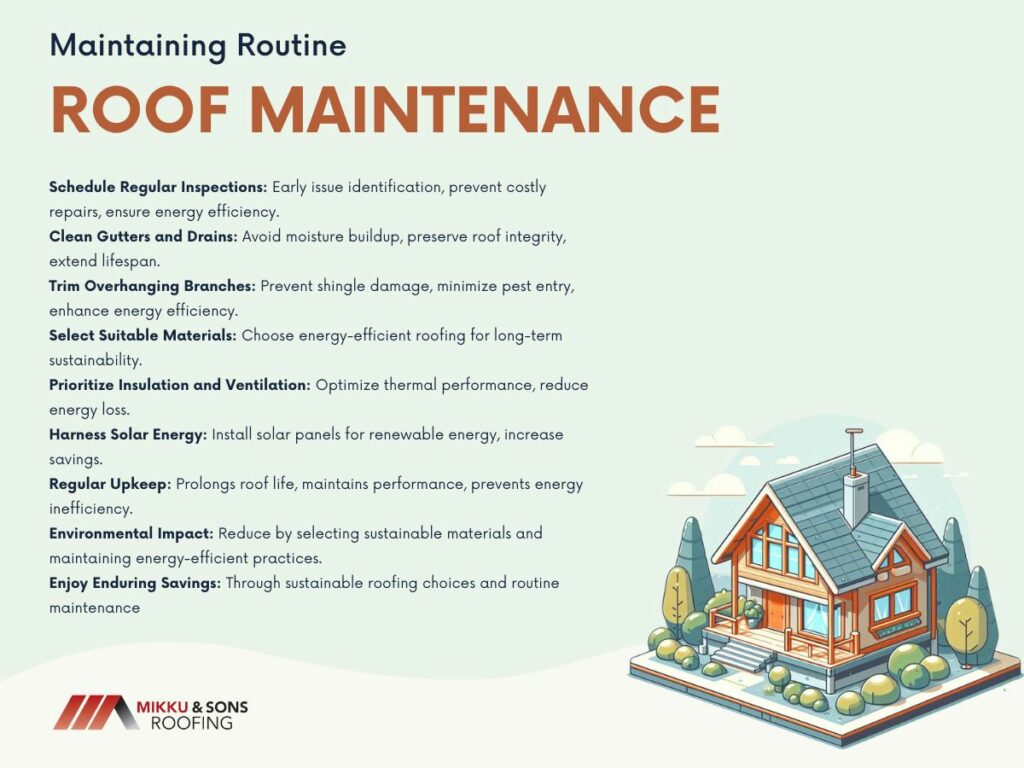
Regular roof inspections by professionals can identify issues early, avert costly repairs and ensure optimal energy efficiency.
Clogged gutters and drains impede proper water drainage, leading to moisture buildup and potential roof and insulation damage. Regular cleaning preserves roof integrity and extends its lifespan.
Overhanging branches can damage shingles and provide entry points for pests. Trimming trees around your home minimizes the risk of roof damage and enhances energy efficiency.
By selecting suitable roofing materials, prioritizing insulation and ventilation, harnessing solar energy, and maintaining regular upkeep, you can substantially reduce your environmental impact while enjoying enduring energy savings.
A well-designed and properly maintained roof can significantly impact a home's energy consumption, comfort levels, and environmental footprint.
Here are the importance of roof energy efficiency and strategies to achieve it.
Your roof plays a vital role in regulating the temperature inside your home. In hot climates, a poorly insulated or heat-absorbing roof can lead to excessive heat gain, requiring more energy for cooling. Conversely, in cold climates, inadequate insulation can result in heat loss, necessitating higher heating expenses.
A well-insulated and ventilated roof helps maintain consistent indoor temperatures, enhancing comfort levels for occupants year-round. Proper ventilation also reduces the risk of moisture buildup and mold growth, contributing to a healthier indoor environment.
By improving roof energy efficiency, homeowners can significantly reduce their energy bills. A well-insulated roof minimizes heat transfer between the interior and exterior, reducing the heating, ventilation, and air conditioning (HVAC) system workload.
Additionally, integrating renewable energy technologies such as solar panels into the roof can further offset energy consumption and lower utility costs.
The benefits of roof energy efficiency extend beyond mere cost savings, impacting both homeowners and the environment in numerous ways. Here are some additional advantages:

Energy-efficient roofing systems are often designed to withstand environmental stressors such as temperature fluctuations, UV radiation, and moisture exposure. By minimizing thermal expansion and contraction, reflective coatings, insulation, and proper ventilation can help prevent premature deterioration of roofing materials, thereby extending the roof's lifespan.
Energy-efficient features, including roofing systems, are increasingly valued by homebuyers due to their potential for long-term cost savings and environmental benefits. Investing in a roof with high energy efficiency ratings can increase the resale value of a home and make it more attractive to prospective buyers.
Energy-efficient roofs contribute to environmental sustainability by reducing greenhouse gas emissions associated with energy consumption. By lowering energy demand, these roofs help mitigate the environmental impact of fossil fuel combustion for electricity generation, thereby reducing air pollution and carbon emissions.
Many jurisdictions have adopted building codes and standards that mandate minimum energy efficiency requirements for residential and commercial buildings, including roofing systems. Installing energy-efficient roofs ensures compliance with these regulations, avoiding potential penalties and ensuring the safety and comfort of occupants.
In some regions, homeowners may be eligible for financial incentives, rebates, or tax credits for investing in energy-efficient roofing systems. These incentives can help offset the upfront costs of installation and accelerate the return on investment, making energy-efficient roofing more accessible and affordable for homeowners.
Overall, the benefits of roof energy efficiency are multifaceted, encompassing economic savings, improved comfort, environmental stewardship, and increased property value.
By prioritizing energy-efficient roofing solutions, homeowners can enjoy a range of advantages while contributing to a more sustainable and resilient built environment.
In addition to the strategies already mentioned, here are some additional recommendations to maximize energy efficiency with your roof further:
By incorporating these additional recommendations into your roofing project, you can further optimize energy efficiency, reduce environmental impact, and create a more sustainable and comfortable living environment for years to come.
Maximizing energy efficiency with your roof is a wise investment with multifaceted benefits. By implementing reflective roofing materials, insulation, ventilation, renewable energy integration, and innovative design, you can lower energy consumption, reduce costs, and enhance comfort.
These efforts contribute to extended roof lifespan, increased property value, compliance with regulations, and environmental stewardship. As we strive for sustainability, optimizing roof energy efficiency is a crucial step towards a greener future, improving our quality of life and preserving the planet for future generations.